Rats: Facts about these thin-tailed, medium-size rodents
Rats are thin-tailed, medium-size rodents that are found all over the world.

Rats are thin-tailed, medium-size rodents that originated in Asia and Australia but are now found all over the world. "True rats" are members of the genus Rattus , but other rodent genera are also referred to as rats and share many of the same characteristics. What's the difference between rats and mice? Rats are generally larger, with longer, thinner bodies and long legs.
Here's everything you need to know about rats, their habitats, behaviors and more.

How big can rats get?
With nearly 60 species of rat discovered so far, these rodents come in all sizes. They are typically 5 inches (12 centimeters), or longer, according to Encyclopedia Britannica . The largest species of rat is the Bosavi woolly rat, which was discovered in 2009 in the rainforest of Papua New Guinea (and doesn't have a scientific name yet). It is about the size of a cat — 32.2 inches (82 cm) from nose to tail and weighs around 3.3 lbs. (1.5 kilograms), according to CNN .
"It's a true rat, the same kind you find in the city sewers," Kris Helgen , expedition team member and Chief Scientist and Director of the Australian Museum Research Institute, told CNN.
One of the smallest rats ever discovered is Osgood's Vietnamese rat ( Rattus osgoodi ). It is typically 5 to 7 inches (12 to 17 cm) long.
According to the Australian Broadcasting Corp. , male rats are called bucks; females are does. Infants are called pups or kittens. A group of rats is called a mischief.
Where do rats live?
Rats are found all over the world. For example, the ricefield rat ( Rattus argentiventer ) is found in Southeast Asia, the Australian swamp rat ( Rattus lutreolus ) is found in Eastern Australia, and Norway rats ( Rattus norvegicus ), also called brown rats, are found on every continent of the world except Antarctica, according to the Animal Diversity Web at the University of Michigan .
The brown and the house rat ( Rattus rattus ) are the most common rats in the world because they have taken boats to every country over the past few centuries. House rats typically like warmer climates, while brown rats live in temperate climates. They typically live anywhere humans live. Many rat species also live in trees.
Overall, rats live to forage and mate. Most rats are nocturnal, though the brown rat is often awake day or night.
Rats usually stick together in groups called packs. New packs are formed when a male and female go off on their own and nest in an area that doesn't already contain a pack. Brown rats are usually led by the largest male in the pack. Other rats may have several dominant males or females in a pack.
What do rats eat?
Rats are omnivores, but many prefer meat when they can get it. House and brown rats usually use humans for their primary food source. They will scavenge through trash or eat any food that is left unprotected.
Rats have also been known to eat grain or kill insects, water creatures such as snails, fish and mussels, small birds, mammals and reptiles for food. Other rats, such as the Sulawesi white-tailed rat and Hoffman’s rat, prefer vegetarian fare such as seed and fruits, according to Encyclopedia Britannica.
Rat breeding
Before their offspring are born, rats build nests from any material that can be foraged from the area, including branches, grass, trash and paper. These nests are usually built in crevices, in rotting trees or in buildings.
Rats, generally, are baby-making machines. Female rats can mate around 500 times in a six-hour period and brown rats can produce up to 2,000 offspring in a year, according to Discover Magazine . Brown rats can have up to 22 young at once, though eight or nine is more the average. Tropical rats tend to only have one to six babies at once.
After a gestation period of 21 to 26 days, babies that weigh only around 6 to 8 grams (.21 to .28 ounces) are born, according to the American Fancy Rat and Mouse Association. By the age of three months, the brown rat is ready to reproduce. Rats typically live around two or three years. Most house rats — 91 to 97% — die within their first year of life, according to the University of Michigan .
Rat taxonomy
Here is the taxonomy of rats according to ITIS:
- Kingdom: Animalia
- Subkingdom: Bilateria
- Infrakingdom: Deuterostomia
- Phylum: Chordata
- Subphylum: Vertebrata
- Infraphylum: Gnathostomata
- Superclass: Tetrapoda
- Class: Mammalia
- Subclass: Theria
- Infraclass: Eutheria
- Order: Rodentia
- Suborder: Myomorpha
- Superfamily: Muroidea
- Family: Muridae
- Subfamily: Murinae
- Genus: Rattus
Common rat species
Common rat species include:
- Rattus argentiventer — Ricefield rat
- Rattus hoffmanni — Hoffmann's Sulawesi rat
- Rattus lutreolus — Australian swamp rat
- Rattus norvegicus — Norway rat, or brown rat
- Rattus osgoodi — Osgood's Vietnamese rat
- Rattus rattus — House rat, or black rat
- Rattus xanthurus — Northeastern Xanthurus rat, or Sulawesi white-tailed rat
Rat conservation status
The International Union for Conservation of Nature (IUCN) lists 16 rat species on its Red List of Threatened Species. They are considered threatened with extinction due to loss of habitat and decreasing populations.
Near Threatened
- Rattus elaphinus (Sula Archipelago rat)
- Rattus feliceus (Spiny Seram Island rat)
- Rattus jobiensis (Yapen rat)
- Rattus hoogerwerfi (Hoogerwerf’s Sumatran rat)
- Rattus palmarum (Zelebor’s Nicobar rat)
- Rattus richardsoni (Glacier rat)
- Rattus satarae (Sahyadris forest rat)
- Rattus stoicus (Andaman rat)
- Rattus xanthurus (Northeastern Xanthurus rat)
- Rattus burrus (Miller's Nicobar rat)
- Rattus hainaldi (Hainald’s Flores Island rat)
- Rattus lugens (Mentawai Archipelago rat)
- Rattus montanus (Sri Lankan mountain rat)
- Rattus ranjiniae (Ranjini’s field rat)
- Rattus simalurensis (Simalur Archipelago rat)
- Rattus vandeuseni (Van Deusen's rat)
Other rat facts
Brown and house rats have made a number of mammal, bird and reptile species extinct, especially on oceanic islands, according to Encyclopedia Britannica. They have also spread of diseases among humans, including bubonic plague. (However, recent research suggests that parasites living on rats, such as fleas and lice, may be the more likely culprit behind the spread of plague).
Rats aren’t all bad, though. Brown rats are used in laboratories for research. In fact, according to the Foundation for Biomedical Research , 95 percent of all lab animals are mice and rats.
A rat’s front teeth grow 4.5 to 5.5 in (11 to 14 cm) each year, according to Discover Magazine. Their sharp front teeth never stop growing.
Additional resources
- Discover Magazine: 20 Things You Didn’t Know About Rats
- Internet Center for Wildlife Damage and Management: Norway Rats
- US Fish and Wildlife Service: Facts About Rats
Sign up for the Live Science daily newsletter now
Get the world’s most fascinating discoveries delivered straight to your inbox.

Patagonian mara: The monogamous rodents that mate only a few times a year but pee on each other constantly
Genetic quirk in 25% of Labrador retrievers can lead to overeating, obesity
'White hat hackers' carjacked a Tesla using cheap, legal hardware — exposing major security flaws in the vehicle
Most Popular
By Anna Gora December 27, 2023
By Anna Gora December 26, 2023
By Anna Gora December 25, 2023
By Emily Cooke December 23, 2023
By Victoria Atkinson December 22, 2023
By Anna Gora December 16, 2023
By Anna Gora December 15, 2023
By Anna Gora November 09, 2023
By Donavyn Coffey November 06, 2023
By Anna Gora October 31, 2023
By Anna Gora October 26, 2023
- 2 India's evolutionary past tied to huge migration 50,000 years ago and to now-extinct human relatives
- 3 Dying SpaceX rocket creates glowing, galaxy-like spiral in the middle of the Northern Lights
- 4 12 surprising facts about pi to chew on this Pi Day
- 5 1,900-year-old coins from Jewish revolt against the Romans discovered in the Judaen desert
- 2 Watch bizarre video of termites trapped in 'death spiral'
- 3 'Potentially hazardous' asteroid Bennu contains the building blocks of life and minerals unseen on Earth, scientists reveal in 1st comprehensive analysis
- 4 Speck of light spotted by Hubble is one of the most enormous galaxies in the early universe, James Webb telescope reveals
- 5 8-hour intermittent fasting tied to 90% higher risk of cardiovascular death, early data hint
How Far Do Rats Travel From Their Nest?

Rats typically travel up to 300 feet from their nest to find food and water, but they may venture further if resources are scarce. This post will explore the range of rat movements and what influences their travel distance. Understanding how far rats roam is crucial for effective pest control and prevention, particularly in urban or residential settings.
- Rats typically travel within a radius of about 300 feet from their nests, but this can vary depending on factors such as food availability, habitat, species, and sensory capabilities.
- Effective rat control requires understanding their nesting habits; rats can nest in various places like underground burrows, attics, and cluttered areas, and tend to return to the same nest if it’s undisturbed.
- Homeowners should take preventive measures against rat infestations by sealing entry points, maintaining cleanliness, storing food properly, and reducing clutter to eliminate potential nesting sites.
- Relocating rats should be done at least one mile away from the capture site to prevent them from returning, but it’s crucial to consider local wildlife regulations and the potential ineffectiveness of this method.
- Rats have a relatively short lifespan of about one year in the wild, which influences their travel range over time, and older rats may have more established routes and territories, making them harder to control.
Table of Contents
Average Distance Rats Travel from Their Nests

Rats are known for their adaptability and resourcefulness, which includes their ability to travel significant distances from their nests in search of food, shelter, and mates. Understanding the travel habits of rats is crucial for effective pest control.
Rats typically travel within a specific radius from their nest. The average distance a rat travels from its nest is about 300 feet (90 meters) . However, this range can vary depending on several factors. It’s important to note that rats will generally not stray too far from their nests unless it is necessary for their survival.

Factors Influencing Travel Distance
Several factors can influence how far a rat will travel from its nest:
- Searching for Food : Rats are opportunistic feeders and will travel farther if food sources near their nest are scarce. They have been known to travel up to 450 feet (137 meters) for food.
- Habitat : Urban rats may not need to travel as far because of the higher availability of food sources, while rural rats might roam over larger areas to find what they need.
- Rat Species : Different species have different ranges. For example, the Norway rat (Rattus norvegicus) tends to have a smaller range than the roof rat (Rattus rattus).
- Sensory Capabilities : Rats rely heavily on their keen sense of smell and touch to navigate and locate food. Poor vision may limit their travel at night, although their other senses compensate for this.
Specific Travel for Food
When it comes to food, rats are motivated travelers. They will often follow the same paths to and from food sources, using their strong sense of smell and tactile cues to navigate. Rats will travel as far as necessary to find food but prefer to forage within 50 to 150 feet (15 to 45 meters) of their nests .
Rat Movement Behaviors and Physical Capabilities
Rats are not only skilled survivors but also have impressive physical and behavioral adaptations that influence their movement patterns.
Rat Migration Patterns
While rats don’t migrate seasonally like some other animals, they will move en masse if their current habitat becomes unsuitable due to factors like food scarcity or extreme weather.
General Movement Behaviors
Rats are typically nocturnal and are most active during the night. They tend to follow established routes along walls and other structural elements, using their whiskers to sense their environment.
Travel in Packs
Rats are social creatures and may travel in groups, especially when young rats follow their mother to learn foraging paths. However, older rats are more likely to forage alone.
Ability to Return to the Same Nest
Rats have a strong homing instinct and can return to their nest even after traveling considerable distances. This ability is crucial for their survival, as it allows them to explore their environment while ensuring they can return to safety.
Physical Capabilities
Rats are agile creatures with several noteworthy physical capabilities:
- Falling : Rats can survive falls from heights that would be serious for other animals, which allows them to explore their environment from various vertical perspectives without significant risk.
- Swimming : Rats are strong swimmers, which can increase the range of their travel, especially in urban areas with waterways.
These capabilities directly influence their travel distances, as rats can navigate complex urban landscapes and return to their nests with relative ease.
Rat Nesting Habits, Social Structure, and Impact on Residential Areas
Understanding rat nesting habits and social structures is essential for homeowners looking to prevent or control rat infestations.
Where Rats Build Nests
Rats are not picky when it comes to nesting locations. They will nest anywhere that provides shelter, warmth, and proximity to food sources. Common nesting sites include:
- Underground Burrows : Especially for Norway rats, which prefer to dig.
- Attics and Roofs : Roof rats, as their name suggests, are adept climbers and prefer high places.
- Cluttered Areas : Garages, basements, and storage rooms that are cluttered provide excellent cover for rat nests.
Return to the Same Nest
Rats are creatures of habit and will often return to the same nest as long as it remains safe and undisturbed. This fidelity to a nesting site can make it easier to target and control rat populations.
Rat Colonies and Burrows
Rat colonies can vary in size, but a typical rat burrow will house a family of rats including a breeding pair and their offspring. The social structure within a colony can influence nesting habits, with dominant rats occupying the most favorable nesting sites.
Implications for Homeowners
For homeowners, the presence of rats can lead to structural damage and health risks. Rats are known to:
- Chew through Wires : Which can create fire hazards.
- Contaminate Food Sources : With their droppings and urine.
- Spread Diseases : Such as leptospirosis and salmonellosis.
Preventive Measures
To prevent rat infestations, homeowners should:
- Seal any cracks or openings larger than a quarter-inch.
- Keep living areas clean and free of food debris.
- Store food in rat-proof containers.
- Reduce clutter and potential nesting sites.
Effective Rat Relocation Strategies and Rat Longevity
When dealing with a rat caught in a trap, relocation is an option that must be handled carefully to be humane and effective.
Guidelines for Rat Relocation
To ensure that a relocated rat does not return, it should be released at least one mile away from the capture site. However, it’s important to consider the following:
- Local Wildlife Regulations : Some areas have laws against relocating rodents due to the risk of spreading diseases.
- Rat’s Survival : Relocated rats may struggle to find food or shelter, especially if released into unfamiliar territory.
Ethics and Effectiveness of Rat Relocation
Relocation should be considered carefully, as it can be stressful for the animal and may not be a long-term solution for pest control. Exclusion and habitat modification are often more effective and ethical strategies.
Lifespan and Travel Range Over Time
Rats typically live for about one year in the wild, but can live up to three years in captivity. The lifespan of a rat influences its travel range over time, with older rats potentially having more established routes and territories.
Concept of ‘Range Rats’
“Range rats” is a term that can be used to describe rats that have a larger than average travel range. These rats may be more challenging to control as they can spread infestations over wider areas.
In conclusion, understanding rat behavior, nesting habits, and physical capabilities are key to effective pest control. Homeowners should focus on prevention and consider the implications of relocation, keeping in mind the health and safety of both humans and wildlife.
What Does a Rat’s Nest Look Like?
A rat’s nest is typically a haphazard structure composed of shredded materials such as paper, cloth, or insulation gathered by the rodents to create a cozy, hidden environment for living and breeding. Rat’s nests appear as a loosely woven, ball-like assembly, often found in undisturbed, dark locations such as attics, walls, or among debris. Urban rats may also construct nests using available detritus, adapting to their environment; whereas, rural and wild rats often utilize natural fibers and vegetation. Each nest is strategically placed within close proximity to food sources, and its disorganized appearance belies its importance for the rodent’s survival, protection, and rearing of young.
How useful was this post?
Click on a star to rate it!
Average rating 0 / 5. Vote count: 0
No votes so far! Be the first to rate this post.
We're glad you found this post helpful.
Share it with your friends!
Our apologies if you found this post unhelpful.
Help us improve this post!
How can it be improved? Your feedback is important to us!
Disclaimer: The content of this post is intended for informational and educational purposes only and should not be seen as professional advice. Exercise caution and consult a professional as needed before acting upon any information provided. We do not guarantee the accuracy, completeness, or reliability of this information, products, services, or related graphics, and are not liable for any decisions made based on it. Use of this blog is at your own risk, and we disclaim responsibility for any losses or damages arising from its use.

Raising My Pets
Do rats live alone or do they need a companion.
Rats fall into the category of highly adaptable rodents that exist in diverse habitats around the world. They have a strange ability to thrive in urban environments and display remarkable intelligence and resourcefulness. These creatures are known for their impressive liveliness and flexibility, making them among the best creatures. Keep reading to know whether rats live alone or not.
No. Rats do not live alone. Rats are always known to be social creatures, and they always like it when they are with others of their kind. In the rat population, they tend to form very tight family bonds. In addition, there is always a dominant rat in the entire population, usually the male in most cases, and some subordinates.
6 Reasons Why Rats Do Not Live Alone
1. they can get depressed.
Rats are social animals. This means that they like being together and enjoy spending time with each other.
If they live alone, they may end up stressed and depressed. This will make their lives easier, reducing their chances of living.
2. They Can Develop Abnormal Behavior
The general health of a rat matters a lot. When they live alone for a long period of time, they may show abnormal behaviors such as aggression and whatnot. That, in turn, becomes risky since its survival chances will decrease as it is constantly disturbed.
3. They May Have a Change in Appetite
Food is usually a basic need not only for humans but also for animals. Surviving without food may be hard or impossible.
In the case of rats, when they live alone, there might be a lot of changes in terms of appetite. The rat will begin to eat less, so its general health will be affected, which could even lead to death.
4. They Begin to Play Less
Playing will always increase activity. A dull rat may be a result of a lack of play. Since rats are used to their own company, they may enjoy playing in that company.
A lonely rat will play less or even fail to play at all. This will make it dull and, hence, make its life more difficult.
5. They May Sleep a Lot
Sleeping too much means reducing activities such as playing or even eating. When a rat is lonely, it may not be able to be as active as one that is with other rats.
In that case, you will notice that the rat will sleep a lot. This is, however, dangerous since sleep without food reduces its life.
6. They May Be Cold
Rats usually sleep in heaps. They do so for a variety of reasons, including being warm. When a rat is alone, especially during the cold season, it may be very difficult for it to survive that weather condition.
You, however, should keep in mind that a lot of colds may make you sick or even lead to death.
Is It Possible to Have Just One Rat?
Yes. It is possible to have one rat. However, it is challenging for that to happen because rats like living in groups. This backs up the point that they are social creatures, and for their survival rate to increase, they need other rats. If you have one rat, you should always consider giving it a mate for a better life.
You may be wondering how many rats typically live together. Typically, rats live in nests where there are usually five to ten rats per nest. Besides living in groups of fives to tens, they usually prefer to live closer to one another. They will later form a social colony and grow their population without problems.
Does Seeing One Rat Mean An Infestation?
Yes. Seeing one rat may mean an infestation. This happens especially when you spot one during the daytime. In normal scenarios, rats are usually active, especially at night compared to the day.
Seeing one rat means that the nest it is living in is overpopulated, leaving you with a total mess that will need attention.
You can deal with the single rat by using a snap trap to kill it instantly, avoiding further disturbance.
Do Rats Ever Live By Themselves?
No. Rats don’t live by themselves. The only time they may live by themselves is when a male rat decides to find another new colony. That is the only time that this may be possible.
So, how can you tell how many rats are in your house? Here are five things that you can look at:
1. By looking at gnaw marks that may be in or around your house
2. By looking at their footprints and directly estimating the number
3. Based on the number of droppings, you may also determine how many there are in your house
4. By checking the number of rat holes available, since rats live in holes too
5. You can also determine that by listening to scratch noises
How Far Do Rats Travel From Their Nest?
100 to 300 feet is how far rats can travel from their nests. In most cases, they travel in search of food and nesting materials to keep them warm.
Where rats live during the day may be your concern. Here is a list of five common places where they live:
1. In storage boxes
2. Under refrigerators
3. Air ducts
4. Behind cabinets
5. Inside woodpiles
Where Do Rats Live Outside?
There are a variety of places where rats live outside. However, these common places include garages, outbuildings, shaded areas, and overgrown places with minimal disturbance.
Knowing when rats come out of hiding is very important. In most situations, they begin to come out around dusk. And in any case, you are wondering, Do rats live underground? Yes, they do.
Jennifer Nelson
Recent Posts
How to Get My Cat to Chew His Food | Tips on What to Do
Cats are domesticated pets whose gums and teeth are built for hunting and tearing the flesh from their hunt. However, today, cats are precious pets in our homes, and it is our obligation to care for...
What Causes Fly Biting Syndrome in Dogs? Facts Behind Dog's Fly-Biting
Dogs are our best friends, as they protect us and our families. They are also a source of comfort and our greatest companions. Their health is one of the most important things we consider. A sick dog...
The Enlightened Mindset
Exploring the World of Knowledge and Understanding
Welcome to the world's first fully AI generated website!
Do Rats Travel in Packs? Exploring the Social Habits and Science Behind Rat Pack Behavior
By Happy Sharer

Introduction
Rats are often known for being solitary creatures, but did you know that some species of rats actually travel in packs? This phenomenon is known as “rat pack living” and it is an interesting behavior that has been studied by researchers all over the world. This article will explore the social habits of rats and how they form packs, as well as the science behind their behavior when traveling in groups. We will also discuss the advantages and disadvantages of traveling in packs, and how rats survive while traveling in groups.
Exploring the Social Habits of Rats – How Do Rats Travel in Packs?
Rat pack living is a behavior that has been observed in many different species of rats, including Norway rats, roof rats, and woodrats. When forming a pack, the rats will typically live together in large groups and travel together in search of food and shelter. Each rat pack consists of a dominant male, several subordinate males, and several females.
Rat Pack Dynamics
Rat packs have distinct social dynamics and hierarchies. The dominant male is usually the leader of the pack and is responsible for defending the group against predators and other threats. He is also the only rat allowed to mate with the females in the pack. According to research conducted by the University of Pennsylvania, “The dominant male rat’s dominance is maintained by his ability to use aggressive behaviors such as chasing, biting, and fighting.”
Types of Rat Pack Formation
Rats can form packs in a variety of ways, depending on the species and environment. Some species of rats will form packs when food is abundant, while others may form packs when faced with environmental pressures such as cold temperatures or lack of shelter. In some cases, rats may even form packs spontaneously, without any apparent external factors driving them to do so.
Benefits of Group Living
Group living has several benefits for rats, including better protection from predators, increased access to food and resources, and improved reproductive success. Studies have shown that rats living in groups are less likely to be killed by predators than those living alone, and they are also able to find food more quickly and efficiently. Additionally, living in a group provides rats with a larger pool of potential mates, which increases the chances of successful reproduction.
The Science Behind Rat Pack Behavior – How Do Rats Communicate and Interact When Traveling in Groups?
Rats are highly social animals and they communicate and interact with each other in a variety of ways. These behaviors include scent marking, vocalizations, and body language.
Scent Marking
Scent marking is a common behavior among rats and it is used to mark territory and identify members of the pack. Rats secrete pheromones from glands located on their bodies and these pheromones act as signals for other rats. For example, a rat may leave a scent mark to indicate that an area is part of its territory, or to let other rats know that it is part of the same pack.
Vocalizations
Rats produce a variety of vocalizations that are used to communicate with other members of the pack. These vocalizations include squeaks, chirps, and squeals and they can be used to express a range of emotions such as excitement, fear, or aggression.
Body Language
Rats also use body language to communicate with each other. They may groom each other, show submission by lying on their backs, or display aggression by standing tall and baring their teeth. Understanding these non-verbal cues is essential for rats living in packs and it allows them to effectively communicate with one another.
A Closer Look at Rat Pack Life – What Are the Advantages and Disadvantages of Traveling in Packs?
Traveling in packs has both advantages and disadvantages for rats, and it is important to consider both when evaluating their behavior. Let’s take a closer look at the pros and cons of rat pack living.
Advantages of Traveling in Packs
As mentioned earlier, traveling in packs has several benefits for rats, including better protection from predators, increased access to food and resources, and improved reproductive success. Additionally, living in a group provides rats with companionship, which helps to reduce stress and increase their overall wellbeing.
Disadvantages of Traveling in Packs
There are also some drawbacks to rat pack living. For example, living in a group can lead to heightened competition for resources, as there are more rats competing for the same food and shelter. Additionally, living in a group can lead to increased aggression and conflict, as each rat must compete for dominance within the pack.
A Day in the Life of a Rat Pack – How Do Rats Survive While Traveling in Groups?
So, how exactly do rats survive while traveling in groups? Let’s take a look at a typical day in the life of a rat pack.
Foraging for Food
Rats are opportunistic feeders and they will eat almost anything they can find. During the day, the rats will forage for food in small groups, searching for seeds, fruits, insects, and other small animals. They will also scavenge for scraps and leftovers in trash cans and dumpsters.
Avoiding Predators
Rats are prey animals and they are constantly on the lookout for predators such as cats, dogs, and birds of prey. To protect themselves, rats will stay close to one another and use their sense of smell and hearing to detect danger. If a predator is spotted, the rats will flee in different directions to confuse the predator and increase their chances of escape.
Building Nests
At night, rats will return to their nests to rest and sleep. Nests are typically built in dark, sheltered areas such as burrows, hollow trees, and attics. The rats will line the nest with soft materials like shredded paper and fabric to keep warm and comfortable.
In conclusion, we have explored the social habits of rats and how they form packs. We have also discussed the science behind their behavior when traveling in groups, as well as the advantages and disadvantages of group living. Finally, we have looked at how rats survive while traveling in groups, including foraging for food, avoiding predators, and building nests. Rat pack living is an interesting phenomenon that is worth further study.
This article explored the social habits of rats and their behavior when traveling in packs. It looked at the science behind rat pack formation and communication, as well as the advantages and disadvantages of group living. It also examined how rats survive while traveling in groups, including foraging for food, avoiding predators, and building nests.
Further Resources
If you would like to learn more about rat pack living, here are some additional resources:
- Social Organization of Norway Rats
- Rat Pack Behavior
(Note: Is this article not meeting your expectations? Do you have knowledge or insights to share? Unlock new opportunities and expand your reach by joining our authors team. Click Registration to join us and share your expertise with our readers.)
Hi, I'm Happy Sharer and I love sharing interesting and useful knowledge with others. I have a passion for learning and enjoy explaining complex concepts in a simple way.
Related Post
Exploring japan: a comprehensive guide for your memorable journey, your ultimate guide to packing for a perfect trip to hawaii, the ultimate packing checklist: essentials for a week-long work trip, leave a reply cancel reply.
Your email address will not be published. Required fields are marked *
Expert Guide: Removing Gel Nail Polish at Home Safely
Trading crypto in bull and bear markets: a comprehensive examination of the differences, making croatia travel arrangements, make their day extra special: celebrate with a customized cake.
Scientist at work: Revealing the secret lives of urban rats
Scholar-in-Residence, Hofstra University
Disclosure statement
Michael H. Parsons does not work for, consult, own shares in or receive funding from any company or organisation that would benefit from this article, and has disclosed no relevant affiliations beyond their academic appointment.
View all partners

In an era when we can decode language among animals and design coatings that make military weapons virtually invisible, it may seem that there are few things science cannot accomplish. At the same time, we are surprisingly ignorant about some things that are much more ordinary. For me, perhaps the most intriguing example is city rats, which in many ways are the most important species of urban wildlife in our increasingly urbanized world.
Because rats are small, vigilant and live mainly underground, even behavioral ecologists like me know remarkably little about how they move through cities and interact with their environments. That’s a problem because rats foul our foods, spread disease and damage infrastructure. As more people around the world move to densely packed cities, they become increasingly vulnerable to rat behaviors and diseases. That makes it critically important to understand more about rats and the pathogens they carry.
I decided to study urban rats to help fill some gaps in our knowledge of how they use their sense of smell to seek favored resources (food and potential mates), and how this attraction influences their fine-scale movements across particular types of corridors.
Small animals with big impacts
Rats like to feed on small quantities of human rubbish while remaining just out of sight, so they have been associated with humans since the rise of agriculture. The ancestors of today’s urban rats followed humans across the great migratory routes, eventually making their way by foot or ship to every continent.
In cities, rats can enter buildings through openings as small as a quarter. They also may “vertically migrate” upward and enter residential dwellings through toilets . Because rats often make their way into homes from parks, subways and sewers, they can transport microorganisms they pick up from decomposition of wastes, thus earning the colloquial nickname of “disease sponges.”
Unlike humans, rats are not limited by the density of their population. In population biology, they are referred to as an “r-adapted species,” which means they mature rapidly, have short gestation periods and produce many offspring. Their typical life span is just six months to two years, but a female rat can produce up to 84 pups per year, and pups reach sexual maturity as soon as five weeks after birth.
Like other rodents (derived from the Latin word “rodere,” to gnaw), rats have large, durable front teeth. Their incisors rank at 5.5 on the Mohs scale, which geologists use to measure minerals’ hardness; for comparison, iron scores around 5.0. Rats use their constantly growing incisors to gain access to food. They can cause structural damage in buildings by chewing through wood and insulation, and trigger fires by gnawing on wiring. In garages, rats often nest inside cars , where they will also chew through insulation, wires and hoses.

In addition to causing physical damage, rats spread diseases directly by passing infectious agents through their blood, saliva or wastes, and indirectly by serving as hosts for disease-carrying arthropods such as fleas and ticks. They are known vectors for Lyme disease, Rocky Mountain spotted fever, Toxoplasma, Bartonella, Leptospira and other microorganisms, many as yet unnamed. A seminal 2014 study found 18 novel viruses in 133 rats collected in Manhattan.
Studying rats in the city
Although they are abundant, wild rats are exceptionally difficult to study. They are small, live mainly underground and are active at night, out of most humans’ sight. When people do see rats they are most likely to notice either the sickest or the boldest individuals – such as the “pizza rat” captured in a 2015 viral video – and make inaccurate generalizations about all rats.
Scientists study animal behavior by analyzing many individuals so that we can detect variations and patterns in behaviors within a population. It may be funny to see a rat drag a whole slice of pizza down subway stairs, but it is much more interesting and useful to know that 90 percent of a population is drawn to foods that are high in fat and protein. To draw conclusions like this, we need to observe how many individual animals behave over time.
Biologists typically track wild animals and observe their movements by capturing them and fitting them with radio or GPS transmitters. But these methods are nearly useless in urban areas: radio waves cannot pass through rebar-reinforced concrete, and skyscrapers block satellite link-ups.
In addition to physical barriers, working with wild rats also poses social challenges. Rats are the pariahs of the animal world: We associate them with filth, disease and poverty. Rather than striving to learn more about them, most people want only to avoid them. That instinct is so strong that last December an Air India pilot flying a Boeing 787 Dreamliner from Mumbai to London made an emergency landing after a single rat was spotted on the plane.
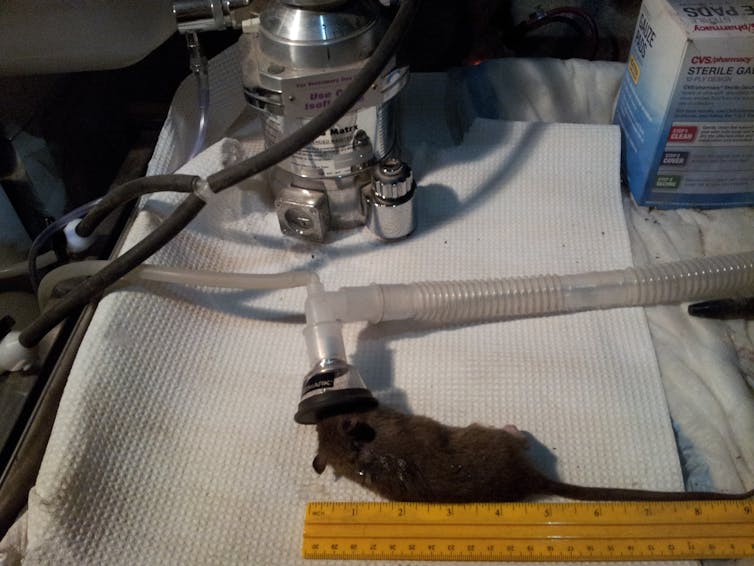
Working with Michael A. Deutsch, a medical entomologist at Arrow Pest Control , I have started designing studies to investigate urban rat behavior in situ so that we can, for the first time, learn the histories of individual animals in the wild. We capture rats by luring them with pheromones – natural scents that they find irresistible – and implant radio-frequency identification (RFID) microchips under their skin to identify each animal. This is the same technology that retail stores use to identify commercial products with bar codes and that pet owners can use to identify their dog or cat if it strays.
After we release the microchipped rats, we use scents to attract them back to specific areas and monitor when and how often they return. Using camera traps and a scale that the rats walk across, we can assess their health by tracking weight changes and looking for new wounds and bite marks. We also test their ability to penetrate barriers, such as wire mesh. And we repeatedly collect biological samples, including blood, stool and DNA, to document the rats’ potential to carry pathogens. We have become familiar enough with some rats to give them names that match their unique personalities.
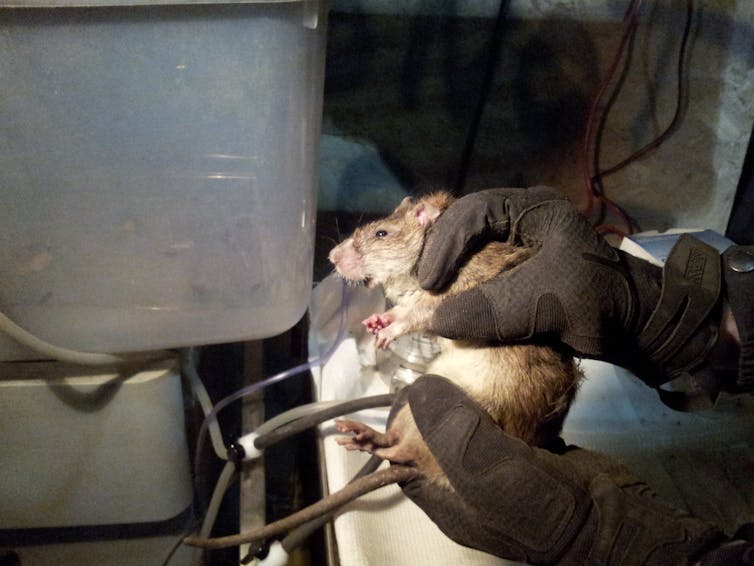
In a pilot study published last year, we reported some initial findings. By monitoring individual rats, we learned that males foraged around the clock 24 hours per day, but females did so only during late mornings. Females and males were equally attracted to scents from lab rats, and females responded to pheromones at the same rate as males.
In 2016 we published our detailed methods as a roadmap that other scientists can use to replicate this research. Using this approach, we believe scientists can learn when and where particular pathogens enter a given rat population. As far as we know, these are the first two studies to analyze wild city rats at the level of the individual in a major U.S. metropolitan area.
Overcoming taboos against studying city rats
In doing this research, I have encountered strong social taboos against working with rats. In 2013, while I was seeking opportunities to carry out field research on rats in New York City, I requested access to the CCTV surveillance cameras of “Theatre Alley,” a narrow lane in Manhattan’s Financial District where rats scurried at will. Just a few weeks later, I learned that Theatre Alley had been hastily cleaned, changing the setting forever and removing information that could have provided useful insights into rat movements and behavior.

We have also found that there is little money for this kind of research. Although New York City spends a lot of money training pest control workers and finding and exterminating rat colonies through public institutions such as the Metropolitan Transportation Authority and the Department of Health and Mental Hygiene , there are few opportunities for academic studies.
Officials at public agencies think pragmatically and respond to a specific threat after a problem has been reported. Thus, it is understandable that they may be unreceptive to requests for access to subways for theoretical purposes, or for disease-related surveillance in the absence of a demonstrated threat that may or may not come to fruition.
Instead, Michael Deutsch and I are looking for New York City residents who will allow us to do scientific research in their homes, businesses, apartment buildings and other establishments, without fear of publicity, fines or judgment. To do this work on a larger scale, we need to do more work to build bridges between academic research and front-line public health and sanitation agencies.
In New York alone, up to six million people use the subway system every day, coming into close proximity with rats, and nearly one-fourth of more than 7,000 restaurants inspected so far this year have shown signs of rat or mouse activity . We clearly need to know more about urban rats: how they behave, where they travel, when and where they pick up diseases and how long they spread them, how these diseases affect rats’ health and, eventually, how rats transmit infections to humans.
- Pest control
- Scientists at work
- Urban wildlife
- Urban ecology

School of Social Sciences – Public Policy and International Relations opportunities

Partner, Senior Talent Acquisition

Deputy Editor - Technology

Sydney Horizon Educators (Identified)

Deputy Vice-Chancellor (Academic and Student Life)
Do Mice Travel In Packs Or Live Alone? What To Know
As common as mice are, many people don’t know much about their social behavior and how they choose to live with others. They see a mouse or two in their home and don’t know if that means there are more hiding or not!
This guide covers if mice travel in packs or live alone, so you can understand what these critters are up to in your home.
Table of Contents
Mouse social behavior, do mice travel in packs, do mice live in groups, how many mice typically live together, when are they alone, will one group of mice attract more.
Mice might seem like nothing more than pest creatures, but they have surprisingly sophisticated social skills. These animals can develop strong bonds with others. The rodents can play with companions, cuddle with others for warmth, and more.
Those dreaded high-pitched squeaks you hear? They’re how mice communicate with one another. They can also use their sense of smell and physical interaction.
What’s interesting about mice is how they form social structures. Groups often have a social hierarchy, and their individual statuses depend on factors like age, sex, etc. The pecking order is observable in established mice communities, and scientists believe it’s a way to curb aggressive behavior and maintain the tight-knit bond of a community.
We know that mice are social, but do they travel in packs or live alone?
Many people assume that mice are solitary creatures. We have movies and cartoons to thank for that. But in reality, these animals are more likely to live and scavenge with others.
As we said earlier, they’re capable of forming tight bonds. Not only that, but they have a social totem pole that dictates responsibilities and overall social status! It’s fascinating to observe, but it’s awful if you’re dealing with a mouse infestation.
You may see a mouse living alone every once in a while. Mice can venture to areas near the nest on their own. But they rarely travel from one place to another without at least one other mouse as a backup.
These creatures prefer to travel in pairs or groups. There’s strength in numbers, and traveling as a pack offers more protection.
Mice also move as a unit to migrate the colony. It’s rare to find a mouse nest with only a single rodent. They create a large nest, and every mouse works to support it (more on that in a bit).
When the group has to move to a new location, they travel as one for safety. If you ever stumble upon a single mouse that seems to be living alone near a nest, there’s a good chance that the others actually scurried to safety.
These animals are notoriously skittish, preferring to stay in the shadows and out of the light. So when you turn on the lights, they quickly find a hiding spot. Unfortunately, some aren’t so lucky and get separated from the group.
As you probably gathered already, mice do not live solitary lives. They can occasionally venture into the unknowns on their own, but they usually require the support of others to survive. For this reason, mice live in pretty large groups.
If you find a nesting area, there won’t be many small clusters in one concentrated area. Instead, it’ll be one massive nest full of mice!
Mice prefer to live in dark, secluded areas of the home. They choose a quiet spot that doesn’t have too much human traffic. That’s why you often see nests in basements, attics, and other rarely used areas of the home.
You might spot them venturing into holes in the wall, too. These pests love to get into those tight spots to set up shop as a group and drive you crazy!
How mice end up finding their new living spaces can vary. Sometimes, a pair will go off to scout for fresh arrangements. Once they find something, they establish a trail that the entire group of mice can follow when ready to migrate.
Moving nests is often necessary if a new disturbance arises. Whether you or another pest, the nest tries to migrate to safer areas.
Once they establish a nest, the entire group works together. The animals collect nesting materials and set up a comfortable nest for sleeping, eating, and breeding.
So, how many mice will typically be found in the same pack?
There’s no concrete number, and the number of mice in a group depends on how they’ve set up their living situation. These animals are social and rely on one another to get by. But they aren’t forced into living with the nest!
Here’s the thing about mice: They reproduce very quickly. A healthy adult female will have litters of six to eight mice about ten times a year. That’s a lot of young mice that can live their entire lives under your roof!
If you don’t address infestations quickly, they can get out of hand faster than you realize. But does that mean that you’ll see a group of hundreds?
Probably not.
The average group or pack of mice usually has somewhere between 12 and 24 rodents. That’s still a lot, but it’s not as big as it could be.
After giving birth, females will raise their young. During those first few weeks of life, the babies rely on their mothers for everything. From food to safety, the mother takes care of it all.
But mice grow up pretty fast. After about 21 days, they’re old enough to stop relying on their mothers and venture out into the unknown. Many will leave the nest (either alone, in pairs, or in a pack).
A few might stay behind, but most will look for other mice to reproduce and create a new family. What does that mean for you?
Mice could make their way outside the home to build a new nest and reproduce. But they can also stick around, resulting in multiple mice colonies in your home!
Mice prefer to be in a pack with others. There’s safety in numbers, and the social bond they create is critical to their survival. A mouse going out into the unknown alone would be like if you ventured into dangerous unexplored lands on your own with zero support.
It’s not wise or safe.
That said, it can happen. Mice will occasionally travel alone in search of food. It’s a rarity, but you might witness it yourself.
Usually, this only occurs when a mouse feels safe in its surroundings. Maybe the colony has lived in the same uninterrupted area for a long time, and the mouse knows how to get around. When these rodents search for food, they don’t venture too far.
They tend to be no more than 30 feet away from the nest. That’s a reasonable distance because most mice can make it back to safety should anything come up.
Again, mice usually like to scavenge in pairs or small groups. But the occasional solo trip will happen.
You also might encounter a mouse on its own if it gets separated from the group. This happens when a lone mouse is incapable of hurrying to safety with the rest of the group at the first sign of trouble.
A single group of mice could attract others in the area. Now that you understand how mice reproduce and often leave the nest upon maturity, it’s not hard to see how you can have multiple nests in the same home.
So how does the attraction occur?
Mice give off pheromones when they travel. A pack of 12 to 24 mice migrating to another nesting location leaves behind a pheromone trail that others can’t ignore.
The pheromones are how mice communicate. These animals are territorial, so communication isn’t always great.
It’s not uncommon for the attraction to result in aggression. Sometimes, small groups will merge into one, so it’s not a behavior you want to ignore. Just because you eliminate one group of mice doesn’t mean that others aren’t around or that future clusters won’t take advantage of that old nesting spot!
Now that you know all the situations where mice travel in packs or venture out on their own, you can use this information to help assess your current situation. Just because you see a mouse by itself, it doesn’t mean you don’t have a more extensive infestation!
As always, be thorough when examining your own home. You never know what little critters have set up shop!
Previous Post

Does Lysol Kill Bed Bugs? The Surprising Answer

Do Deer Eat Apples & Are These Fruits Good For Them?

How Many Rats Live in a Nest or a Colony?
Table of Contents
If you have seen a rat scurrying around you might start wondering how many more are present that you didn’t see. It is not always obvious how many rats are in a certain area, a fact that is demonstrated by the constant debate about how many rats live in New York City. That being said, there are some ways to make an estimate of the size of a rat colony.
A typical rats nest will be home to about 5 to 10 rats. There are often many nests in close proximity to each other that form a social colony. The size of a colony can be on the order of 100 rats if sufficient food is present to support the population. Both Norway rats and Roof rats use nests to hide and raise their young.
Where Are Nests Located?
Norway rats like to live on the ground or in the sewers and prefer to burrow or dig long tunnels and chambers beneath things like dirt, leaves, wood, and garbage piles to house and nest their colony. For added security, Norway rats will even dig entry and exit ways to go beneath the concrete foundation on the sides of homes, farms, and office buildings . Their rat nests are about 18 inches down, where female rats will have separate chambers to house their newborn rats and young rats.
Roof rats like to jump and climb high up thick trees , dusty attics, barns, garages, walls, and inside ceilings when building their nest. Yet, they can sometimes be found making their nest at the base of trees in certain fruit or nut orchards. Woodrats are very similar to roof rats and will build multiple nests in trees.
What Are Nests Made Of?
Norway rats will use what they find on the ground such as plant fibers, cloth, string, hair, leaves, twigs, and anything they can chew or carry back. This type of rat can climb like a Roof rat but is slower and less agile.
Roof rats are more athletic and persistent. They will climb or jump where they can and collect what they can, and chew through things like wire, plastic, wood, hair, paper, and even wall insulation to make a nest for themselves and their young.
Some people use strings of yarn or other fabric as bait for rat traps as the rodents will try to take the material to build a warmer nest.
When Do Rats Leave The Nest?
Young rats will leave the nest at the age of about 3 months. This is shortly after they have learned, through imitation from their mother, what foods are good to eat. At 3 months, rats are mature enough to reproduce and travel alone.
All rats are nocturnal and will leave their nest from the start of dusk until dawn. If there is a burgeoning rat problem, you’ll see them scurrying across walls and fences, as well as running along the edges of buildings and floors during the day.
Can young rats cause the same damage as an adult rat?
Young rats haven’t lived as long as adult rats, but they can do a huge amount of damage to your home and property. A rat’s front teeth can grow from 4 ½ to almost 6 inches a year, which means they need to chew to file them down. Overpopulation is an imminent threat caused by rats’ rapid sexual development beginning at 3 months old.
How frequently do rats mate?
Roof rats and Norway rats will frequently mate throughout the year in warm climates. Norway rats can birth from 4 to 6 litters every year that they are alive . They typically can have up to 20 pups over the course of that year. Roof rats can have 3 to 5 litters yearly and can birth up to 40 rat pups per year if there are environmental conditions that will cater to it.
How Will I Know If I’ve Found a Rat Nest?
You’ll see holes on the ground or above ground level. This can also mean holes you don’t see, that could be leading into your home through a pipe, vent, or other entrance.

Poop and Urine smell
You will smell the overwhelming or even a faint smell of urine-soaked areas and trails the rats leave behind. Rats have no bladder control. You’ll see fecal pellets everywhere rats like to go as they leave it as a trail and a way to communicate with other rats. Check here for reference pictures of rat poop .
Hair and Oil Streaks
You will probably see their hair stuck to things like rough edges of a wood panel, or on the holes, they’ve chewed through. You might even see your own hair or other animal hair in their nests. Rats are dirty and like to crawl, squeeze, and shimmy through grimy and narrow spaces. You’ll see the black or gray oil streaks they’ve left behind on rafters, beams, walls, and poles. These streaks are hormonal markers that can help rats locate their nest, and also help with attracting mates.
Piles of Debris
They like to chew, so you’ll most likely see the remainders of these objects around your property. Rats like to chew and make piles of the things they eat. They will take these piles back to their nests.
If you can hear active and annoying squeaks and squeals through the night or during the day, you’ve most likely found their nest or where they’ve managed to get themselves stuck. If you’re starting to hear a pattern to their scurries, you’ll be able to follow and trace where their nest is.
Both Roof rats and Norway rats build and live in nests. The key difference is that Roof rats live and nest in high places, while Norway rats live and nest in colonies that are at or below ground level. Both can mate and rapidly multiply, causing overpopulation of rats that can cause a health and safety issue for the people and animals that are surrounded by them. Take action now; one rat can quickly mate and reproduce causing more problems. Do something before it gets out of control.
If you are finding multiple nests on your property then it is time to set out some traps or call an experienced rat exterminator .
About Author
Noah Thompson
See author's posts
You may also like
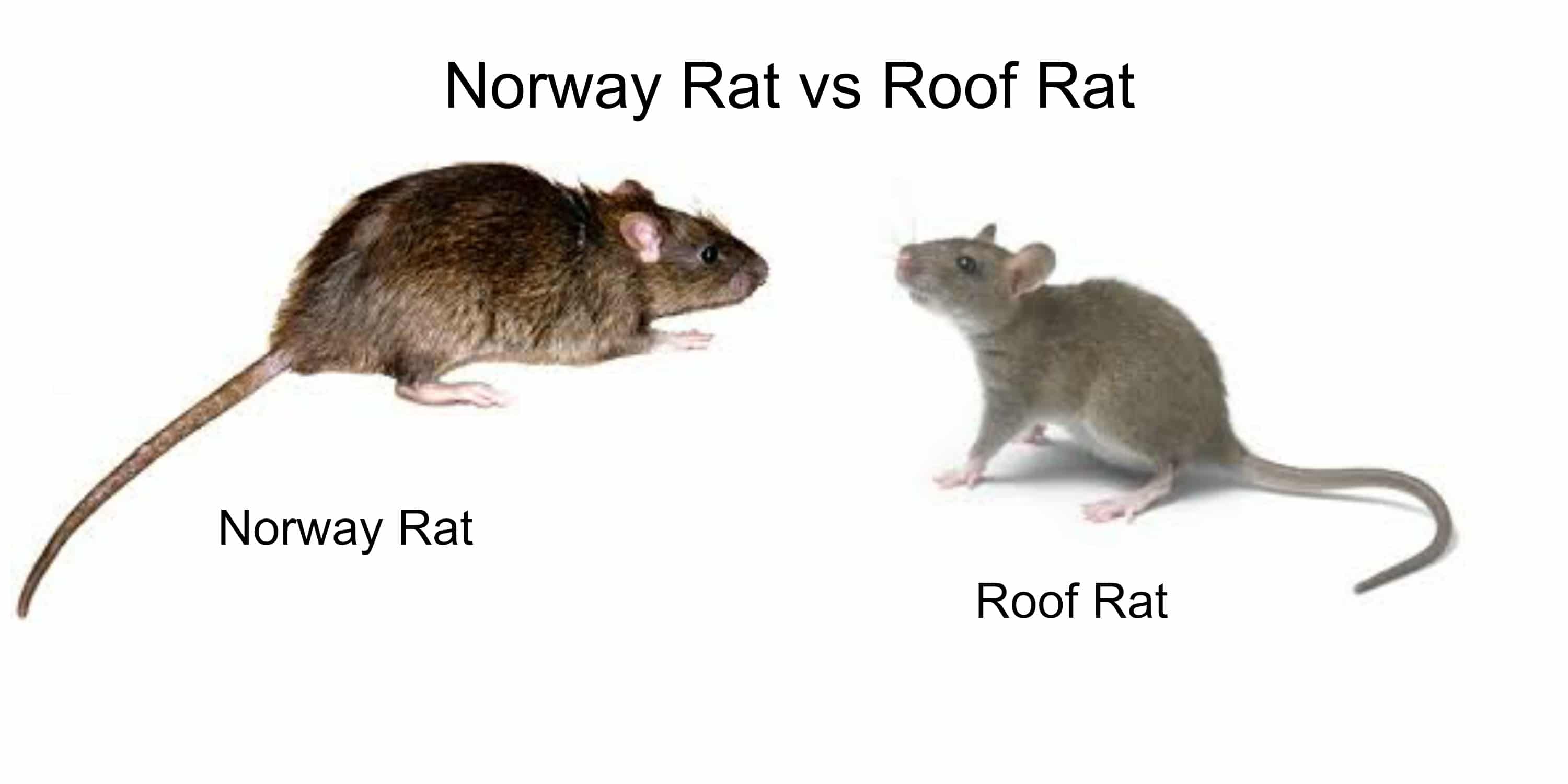
Recent Posts

- DIY Pest Control
- Privacy Policy

Helping You Learn All About Your Pet.
![do rats travel alone Can Rats Live Alone? [Or Do Rats Need To Be In Pairs?]](https://peteducate.com/wp-content/uploads/2020/06/Can-Rats-Live-Alone_-Or-Do-Rats-Need-To-Be-In-Pairs_.png)
Can Rats Live Alone? [Or Do Rats Need To Be In Pairs?]

Owning a rat comes with a range of considerations. One of which will be where you home them and setting up optimal living conditions. On this topic, you will likely wonder whether you can keep them alone. Do they need the company of other rats and should you be looking to keep them in pairs or more? Intrigued, I decided to take a look into the research. Here is what I was able to find.
So, can rats live alone? Rats can live alone, but they should not do so, if at all possible. Rats do best in pairs or even better, in groups. Rats are naturally sociable animals and instinctively stay together (in what is called a mischief). You can observe this in wild rats. Solitude is known to negatively impact a rats well-being and quality of life. A pet rat that lives alone may not necessarily have a shorter lifespan than rats with at least one other companion, but they are likely to be depressed.
Rats by nature are sociable that enjoy the company of their fellow rats. Rats, in the wild, live in large groups.
This way of living is healthy for them, and they have complex hierarchies and relationships within their groups.
They groom one another and sleep together in heaps. Rats look out for each other, and they survive by taking cues from their fellow rats.
Its how they have managed to procreate and survive – its what has given them the ability and confidence to forage, navigate and educate themselves about the environment.
Pet rats are very playful and curious, but they do require a buddy to feel safe and happy. A pet rat doesn’t need to be part of a community, but one other companion will make such a difference in their life that putting at least two together is preferable and makes sense if you can.
Let us now take a closer look at some of the most common questions relating to the topic, and giving you all the information you need to decide how many rats to get.
Table of Contents
Can I Just Have One Rat?
You can have just one rat, but it is not recommended or advised. In fact, there are few reasons to be made for keeping one rat, but several for keeping and looking after several together.
As a loving owner, you want your rat to have the best quality of life and being as happy as possible for those years.
Rats are naturally very social animals. They gain a lot of enjoyment and stimulation in the company of others. It is best for a rat’s health, development, and survival to have the company of at least one other rat.
We can see this in wild rats, where they live in large groups known as a mischief.
As owners, we must therefore try to replicate this in captivity – attempting to give them the most natural life we can. To do this, we can keep them in pairs or more.
Rats that live in groups will have a lot of fun with each other. They will play, groom, sleep, wrestle, communicate and form close bonds with one another. They will spend the majority of time in the company of others, rarely going off to their own peace and quiet. But if they do, they can always return.
A single rat however, can only sleep, eat or wait for their human owner to provide some attention.
Some owners will tell you that they have just one rat, and that their rat appears to be happy. But, this only appears to be the case when the owner is around and actively playing or spending time with the said rat.
You have to consider that when an owner leaves to go to work, run an errand, meet friends, or even during the nighttime hours, the rat will be all alone with no playmate.
Rats that live in groups will have a more varied and stimulating life than what a single rat can ultimately have.
And the truth is, even a small amount of time alone is not conducive to the well-being in this rodent.
Even if you were able to spend all day with your rat, it’s just not the same for them to not be with others. As mentioned, they love to partake in activities together . This is the kind of behavior you will never be able to fully replicate as a human.
So, depriving your rat of the company of their own kind is only likely to lead them to become lonely and depressed.
Isolated rats often develop behavioral issues, like hiding away, being neurotic, chewing on their fur as they are kept in unnatural conditions.
Ultimately, a rat on their own is not likely to be a happy rat.
Do Rats Need To Be In Pairs?
Rats should live in pairs, if not more. So, if you have a large enough cage and you can accommodate more rats, you should do so. Generally, the more, the merrier.
If you are looking for a great cage to house several rats, take a look at this one on Amazon – its ideal.
Rats teach one another social skills; so they will soon learn to become familiar and good in the company of others in which they are homed with.
It is generally advised to keep the same sexes together. In other words, males with males and females with females, as breeding can quickly get out of control.
Entire male, or entire female rats do well in single-sex groups. Equally, male rats that have been neutered could be kept with the opposite-sex.
It has been reported that male rats can become aggressive and begin to pick on other cage mates. This typically occurs during mating season as hormones fluctuate.
While a fair amount of play-fighting is natural and to be expected, bullying, hissing or the fluffing up of fur is usually a sign to look out for that things are getting too much. It is uncommon but important to be aware of.
Neutering tends to reduce aggression, so if often advised by veterinarians to keep aggression under control.
Ultimately, having multiple rats together will also benefit you as an owner. You’ll have the reassurance of knowing your rats are happy in the company of others and able to play together. It takes the pressure of having to be around all the time.
Can Rats Die Of Loneliness?
Rats will not die of loneliness as such. But it is fair to say that loneliness is not conducive to health. This in turn does lead to a greater risk of death from all causes.
Pet rats that get depressed due to a lonely state will eventually give up on their life. This means that they will stop grooming; they will not eat properly and will ultimately die from health issues that are related to this. Its an indirect cause, but its one to be aware of nonetheless.
In other words – a pet rat doesn’t die from loneliness or being alone; a rat’s health can deteriorate and weaken by complications related to the loneliness that can result in death.
One thing is for sure rats need the company of other rats; it does not matter how much interaction they get from their owner – it is not the same.
What Do You Do If You Have One Rat Left?
As rat companions die, the one rat that’s left suffers greatly. It’s a terrible situation for any pet rat and they will grieve.
You must understand the rat’s grieving process; many rats need to see the body of their deceased friend. It may seem odd, but you should place the dead rat’s body in the cage to let the other rat look at it.
The living rat will try to get their friend to move at first but will walk away understanding that their buddy is no longer there. This process can take some time, anywhere between a couple of minutes, if not hours. Its not nice, but it is important.
Your pet rat will start the grieving process, and during this time they will be extra sensitive. You should not leave them alone for long. They will need your company and the more you can give during this time, the better.
You should also consider getting another rat. This will reinstate the group environment company and to help your grieving rat recover long term.
When doing so, factor in the age. If you want to get a younger companion, it is best to get at least two instead of one. This will help reduce future grieving when the older rat inevitably dies.
If you choose not to get any more rats, you must provide your remaining pet rat with all the love and attention they require. They are likely to suffer from loneliness, so it will be a lot of work on your part.
How To Introduce Rats
We now know that keeping rats together is best; but how would one introduce new rats together safely and effectively.
Firstly, it is important to do so gradually and slowly. It is recommended that you also do so away from the cage at first to prevent any territorial behavior and to keep them more easily separated.
From there you can look to place them in the cage together when they are more aware and familiar with one another. Just make sure you clean the cage first because rats are known to pee and scent to mark their territory and this can lead to aggressive behavior.
Rats may become acquainted with one another quickly, or it may take some time. It usually takes around a month for them to become completely friendly to one another.
Either way you need to ensure that fights do not break out. If they do and it does not look like playing, quickly separate them and look to re-introduce them again later after they have had some time away and an opportunity to settle.
Younger rats are generally easier to introduce, but it is possible to introduce older rats to one another. It may just require a bit more time and persistence.
Ultimately, ensuring your rats are comfortable and safe should be your utmost priority.
While rats can live alone, it’s not what is best for them.
Rats, like most rodents, are social animals that live happiest and healthiest in the company of others.
In the wild, baby rats learn from the adults how to groom, play, feed, and scavenge for food, and as adults, they continue to look out for each other by getting cues from each other. The community of these rodents is based on a complex hierarchy.
There is no reason why a pet rat should do without the company of at least one other rat.
As any loving pet owner, you want what’s best for your pet rat, and you want to avoid any health complications associated with loneliness.
It is reassuring for you, as an owner, to know that your rats have one another for company, you don’t have to worry about the happiness of your pet so much.
These rodents need to play, sleep, groom, and interact with each other to maintain top mental and physical health.
Related Questions
Rats can get depressed with the most common causal factor being loneliness. Common signs that could indicate depression include over-eating, under-eating, sleeping more, playing less, or a general lack of thirst and enthusiasm for life. You may notice a more lethargic nature in your rat. Depression is likely to follow the death of another rat if you are keeping more than one at a time.
Rats that are happy are more excitable, inquisitive, and likely to: burrow, make specific noises, gnaw, climb, lick, and groom. You can also detect that a rat is happy by its ears. A happy rat’s ears will hang in a relaxed way to the right side, whereas a stressed rat’s ear will be perked up and situated to the left.

I am an experienced pet owner with decades of experience owning a number of different pets, from traditional pets like dogs and cats, to the more exotic like reptiles and rodents. I currently own a Cockapoo (pictured) called Bailey. I am also the main writer and chief editor here at Pet Educate; a site dedicated to sharing evidence-based insights and guidance, based on my vast pet ownership knowledge, experience, and extensive research.

How Far Do Rats Travel From Their Nest?

I believe in treating all creatures with respect. My mission is to ensure everyone understands how to protect their home from rodents without using cruel methods.
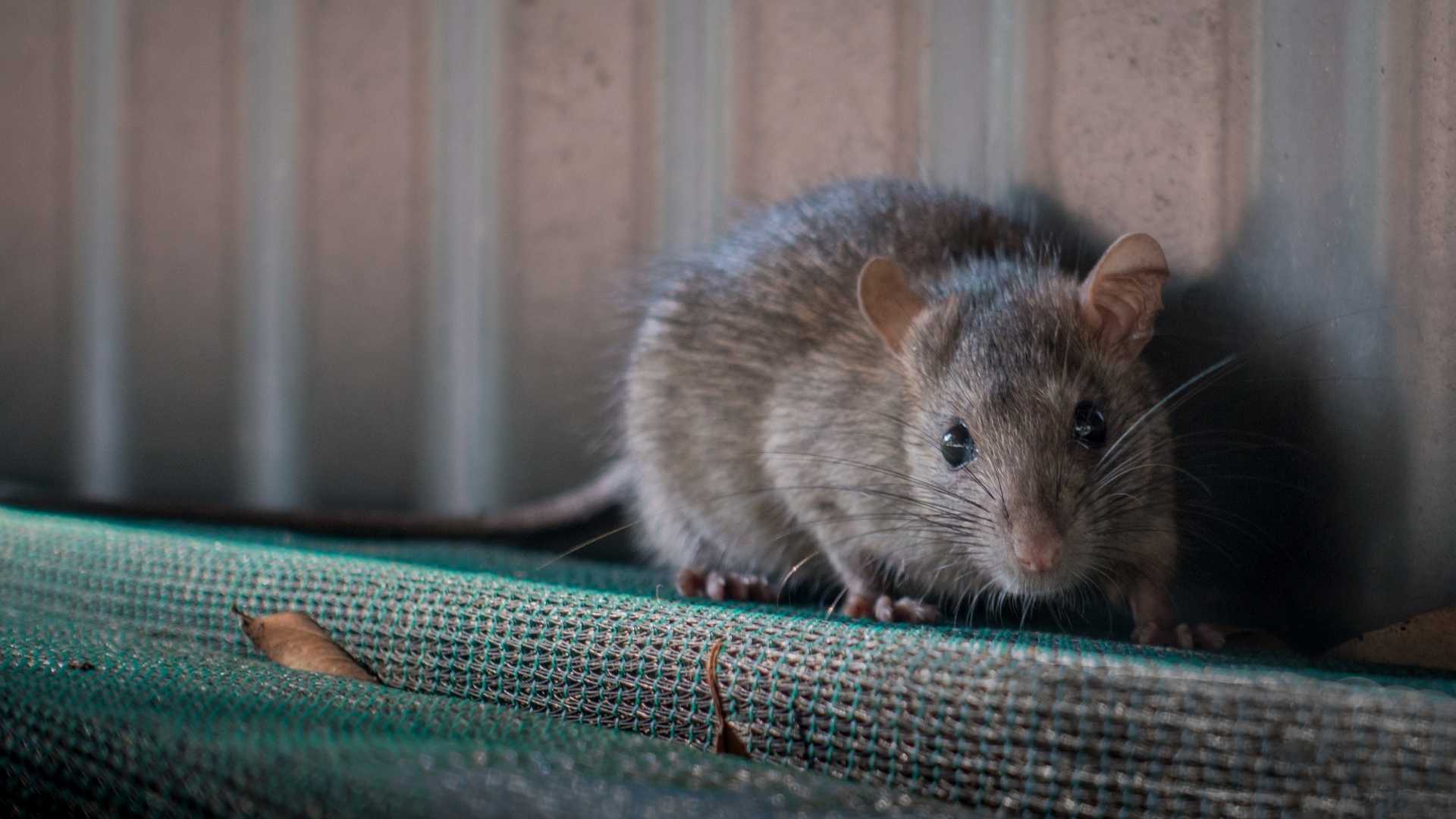
When you come face to face with a rat, you may be struck down in fear! Why? Because it is well known that rats carry some terrible diseases such as leptospirosis , and they also took the rap for helping to spread the bubonic plague !
We know they exist, and we know that we are never too far away from a rat. But what else do we know about rats?
In this post, we will look at how far rats travel from their nest and why they roam that far .

How Far Do Rats Travel From their Nest?
Rats will travel up to 300 feet away from their nest . Whilst that doesn’t seem like a great distance, it is fairly large for a rat, right? If a rat has a family to feed, she will need to drag the food back to the nest once a source has been found, so the shorter the distance, the better!
Bear in mind that this distance is traveled only if a rat is comfortable with the nest it has in terms of safety. If a rat senses the presence of a predator, then it will not leave the nest unattended!
There are many reasons why a rat will leave its nest. Let’s take a look at some below.
Why Do Rats Roam?
Unless a rat has everything they need inside its nest, it will roam to find what they need. Let’s face it… a rat will not have everything needed in a small nest, will they? There is not much room in a nest when it is full of rats babies !

Hunting for Food
The most obvious reason a rat will leave its nest is to look for food.
Luckily for them, rats eat pretty much anything as long as it smells interesting, and sometimes even if it doesn’t! It may sicken you to know that rats will eat dog poop and human poop too! They also enjoy chewing just about anything, but they’re not doing it because it fills their bellies.
In the wild, rats eat a range of fruit, plants, and seeds and are, on the whole, mostly vegetarian. However, rats that live in urban areas have a different diet. A city rat eats garbage and meat, pet food, and any human food they might encounter.
When looking for food, rats rely mostly on their sense of smell. Using their highly developed noses, a rat can detect food from quite a distance away.
Once it’s located their next meal, they’ll carry it away in their mouth and eat it somewhere safe.
Rats tend to build a nest close to a reliable food source, so they don’t have to travel too far.
However, when food is in short supply, they’ve been known to travel more than their average range of 50 to 200 feet from the nest.
A rat needs to consume up to 10% of its body weight in food every day.
Searching for Water
As you might expect, rats cannot live without access to water.
They can survive for a few days if they can’t find water, and it’s also possible for them to get their water from the food they eat.
For example, fruits, berries, and scavenged food can also contain small amounts of water. However, a rat will leave its nest in search of water if it hasn’t had sufficient in several days.
Their Nest Has Been Disturbed
Rats build a nest for their offspring, and it’s made using a range of different materials the rat will have foraged from the local area.
Materials include branches, paper, trash, and grass.
Nests tend to be built in buildings, rotting trees, or any other kind of crevice.
As well as humans, rats have several other natural predators. Cats, birds of prey, snakes, and weasels have all been known to disturb a rat’s nest. When this happens, it’s likely a rat will move its nest to a more secure location.
There is a Large Infestation
If there is a large infestation of rats on your property, for example, you may find them leaving their nest during the day.
Generally, rats are more nocturnal creatures unless there are lots of them living in one area, then they are more likely to make an appearance!
How Do Rats Travel?

Rats are very cautious rodents and clever too. They are fully aware of all the dangers that other animals and people pose to them.
They have predators on foot ( cats eat rats , for instance) and predators in the air (birds of prey). To reduce the chances of being an easy meal for a predator, rats will travel through covered areas and do most of their traveling after sundown.
When it is dark, a rat is less likely to be caught. Having said that, it is not uncommon to see a rat during the day .
Do Rats Leave The Nest?
Yes – rats do leave their nests for several different reasons. Such as:
- Fear for safety
- Sense a predator (such as a cat)
- Disturbed by humans or other animals
Do rats come back to the same place?
Rats are known to be very curious creatures and will often explore their surroundings, but they typically don’t travel far from their nests. Home ranges for brown rats have been found to average about 300 feet in rural areas and less in urban areas.
Male rats tend to have larger home ranges than females. While rats will occasionally travel greater distances, most stick close to familiar areas where they know there is food and shelter.
Ultimately, a rat will always return to its nest unless you’ve caught it in a trap!
Where do rats go during the day?
Rats are nocturnal creatures and are rarely seen during the day. If you see a rat during the day, it is likely because its nest has been disturbed, it feels threatened, or it is looking for food. As I mentioned above, rats will travel up to 300 feet from their nest in search of food.
What happens if you disturb a rat’s nest?
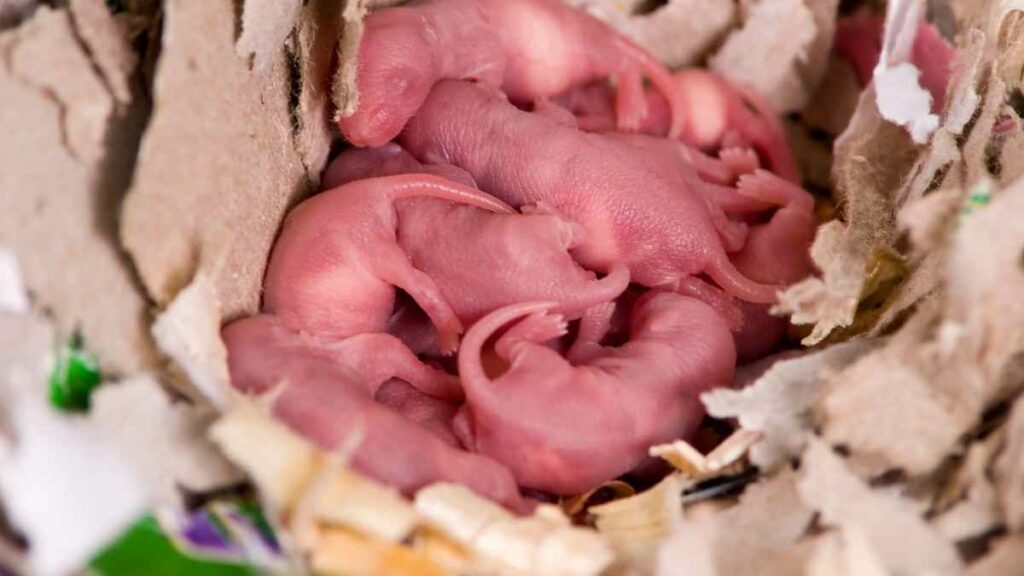
If you discover a rat’s nest, it is best to leave it undisturbed unless you are comfortable with removing it yourself.
The mother rat will often move her young to a new location if she feels that the nest has been disturbed and they are at risk. If you must remove the nest, do so carefully and place it in an area where the rats will not be able to access it to stop them from coming back.
It is also important to remember that rats can carry diseases, so it is important to take precautions if you come into contact with one.
Do rats follow the same route?
If they have surveyed the local area, rats usually follow the same route when they travel from their nest.
If you see a rat on your property, it is likely that there is a nest nearby. Find out where the rat is coming from, block off that area, or smoke out the nest. If you have a lot of rats on your property and you are not comfortable with DIY rodent control techniques, you may need to call a professional pest control company to help get rid of them.
This post has given you an insight into how far rats travel from their nest and has also identified reasons why a rat will travel.
What does it mean in real terms?
Well, they say that in big, populated cities, we are only ever 10 feet away from a rat. That means we are never too far away from a rat’s nest !
Out in the sticks, I imagine that could be slightly worse, but who knows!
Related Posts:

Can Mice Climb? Yes – And Here Is A Detailed List
5 Best Mouse Trap Options For Multiple Mice
About the Rodent Guide
I’m an expert in do-it-yourself rodent control. For more than 20 years, I’ve dedicated my life to helping people live harmoniously alongside these critters by sharing rodent control solutions that are effective and kind.
Leave a Comment Cancel reply
Diy rodent control techniques - disclaimers.
The articles on Rodentguide.com are informational only and are regarding DIY rodent control tips I have picked up from my own experience. If you require professional advice, please contact a rodent control company.
Rodentcontrol.com is a participant in the Amazon Services LLC Associates Program, an affiliate advertising program designed to provide a means for sites to earn advertising fees by advertising and linking to Amazon.com, Amazon.co.uk, and other Amazon stores worldwide.
© 2024 Rodent Guide

- Rat Behavior
Can Rats Live Alone? The Truth Behind Solitary Rat Lifestyles
- August 4, 2023
Share Article Link
Welcome to the Rat Blog , where we delve into the fascinating world of our furry little friends. Today, we tackle a common question among rat enthusiasts and potential owners alike: can rats live alone? As an experienced rat owner and enthusiast, I’m here to provide you with the answers and insights you need to make informed decisions about your pet rat’s welfare.
Understanding the Social Nature of Rats
Rats are highly social animals by nature. They thrive in the company of other rats, forming strong bonds within their groups. In the wild, rats live in colonies, and these social structures are deeply ingrained in their genetic makeup. It is vital for us as rat owners to recognize and respect their natural inclination towards social interactions.
The Importance of Company for Rats
Rats are intelligent creatures that require mental stimulation and companionship to lead fulfilling lives. Without social interaction, they can become bored, lonely, and may experience decreased overall well-being. When rats are kept alone, they can exhibit signs of stress, depression, and behavioral issues.
Exceptions to the Rule

While rats generally thrive with companionship, there are a few exceptions to consider. Certain circumstances may necessitate the temporary isolation of a rat, such as when a rat is sick or recovering from surgery. However, it is crucial to closely monitor their behavior during isolation and ensure they receive ample interaction and mental stimulation from their human caregivers.
Introducing New Rats
If you’re considering adding another rat to your existing furry family, introducing them properly is essential. Rats are territorial creatures, and improper introductions can lead to aggression and stress. Start by providing separate cages for both rats, allowing them to get used to each other’s scent through gradual exposure. Monitor their behavior closely during playdates and gradually increase the duration of supervised interactions. A successful introduction can lead to a harmonious coexistence and a happy rat community.
Alternatives for Solo Rats
In circumstances where rats cannot live with companions due to aggressive tendencies or health issues, providing alternative forms of companionship becomes crucial. Spending quality time with your solo rat through play, training sessions, and enrichment activities can help alleviate their loneliness. Consider adopting social interaction techniques designed for human-rat bonding, such as clicker training or teaching new tricks . Additionally, providing plenty of toys, hiding spots, and rotating their environment can also help keep them mentally stimulated and engaged.
Conclusion and Final Thoughts
In conclusion, while rats are highly social animals that thrive in the company of their own kind, there are certain circumstances where they may need to live alone temporarily or permanently. However, it is essential to closely monitor their behavior, provide ample mental stimulation, and consider alternative forms of companionship if solo living is necessary. As responsible rat owners, it is our duty to prioritize their well-being and meet their social and emotional needs to ensure they lead happy, enriched lives.
Remember, understanding the social nature of rats and providing proper companionship is key to creating a fulfilling life for your rat. Whether you decide to introduce a new furry friend or focus on providing alternative sources of mental stimulation, your rat will thank you for being an attentive and caring owner.
For more rat-related articles and advice, explore the Rat Blog archives or follow us on social media for regular updates and tips.
Thank you for joining me on this exploration into the world of rats. Until next time, keep your furry pals happy and healthy!
Leave a Reply Cancel reply
Your email address will not be published. Required fields are marked *
Save my name, email, and website in this browser for the next time I comment.
Related Posts
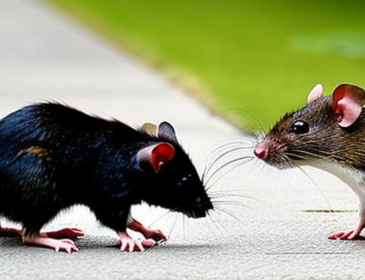
- March 3, 2023
Understanding rat behavior: What your rat is trying to tell you

- March 15, 2023
Dwarf Rats: Everything You Need to Know About These Rodents
Alice Garcia
Recent posts, the best books, movies, and games featuring rats, how to identify and solve rat behavior problems, the different types and colors of rats, how to travel with your rat safely and comfortably, how to groom your rat and keep them clean, the history and evolution of rats.
Rat Training
Rat Behaviour
Rat Stories

Join The Rat World!
Sign up for our newsletter and get the latest news and updates on all things rat-related. 🐀

Copyright © 2023 The Rat World. All rights reserved.
- Get an instant quote
- Call me back
- Join Mailing List

How Far Do Rats Travel from Their Nest?
Rats can travel up to 90 meters from their nest. Normally however, they will only travel as far as in necessary to find food, water, shelter, or nest building materials. As nocturnal creatures, rats do most of their exploring at night.
How do rats navigate?
Rats follow their noses. A rat’s sense of smell is significantly more powerful than even that of a dog. Because of their acute sense of smell, rats have been used to sniff out landmines in Mozambique. The little creatures have also been used to detect illness in humans, such as tuberculosis. While out scavenging, rats can pick up a scent from food, and follow their nose to reach it.
Rats prefer to move around without being seen. As such they tend to avoid wide open spaces, and instead stick to areas where it’s harder to see them. Favourite corridors for rats include ditches, hedges and trees, pipes and gutters, along walls or fences.
How to prevent rats getting into your property
The best way to prevent rats from entering your property is to identify and block all entry points. An entry point is any hole 20mm or larger, or gap that leads into your building. 20mm is the diameter of a penny. This means that to prevent entry of rats, you need to seal all penny sized gaps into the building. If you want to mouse-proof too, then your building you should aim to fill all 5mm gaps.
The process involves walking around your property and searching for the gaps. Once you find a gap, stuff it with wire wool and polyfila or place a galvanised mesh sheet over the top with adhesive.
Popular places for gaps include:
- Where telephone wires and other cables enter
- Gaps around doors
- Gaps under garage door
- Around windows
- Through holes in air bricks
- Under eaves leading to attic
How high can rats climb walls?
How high rats can climb depends on the texture of the wall. The rougher the texture, the easier it will be to climb. Here is a video of a rat climbing a wall:
This means that while you search for rat-sizes gaps to fill, you shouldn’t limit your search to the lower half of the building, but instead you may need to look for gaps everywhere from the foundation to the roof.
Even if your walls are silky smooth, then consider that rats can jump almost 1 meter vertically. It’s common place for rats to reach heights by hopping from surface to surface. Common surfaces that rats use to get high up are, bins or other objects stacked next to walls, window sills, adjoining walls or fences, and nearby branches.
How to rat-proof the easy way?
The easy way to rat proof is to call a pest control expert. Merlin can help you . We cover the entire UK and Republic of Ireland. Get in touch.
Blog Categories
- Impact of Covid on Animals (6)
- Pest Control Techniques (6)
- Bed bugs (11)
- Carpet Beetles (3)
- Cockroaches (7)
- Rodents (12)
- Silverfish (2)
News Categories
- Merlin News (6)
- Industry News (4)
ENTER YOUR DETAILS BELOW TO REQUEST A CALL BACK AND WE WILL GET BACK IN TOUCH AS SOON AS POSSIBLE.

- [email protected]
- Call - we service 300 locations
- Squirrel Removal Guide
- Squirrel Damage Photos
- Squirrel Trapping
- Squirrel Prevention
- Nest of Baby Squirrels
- Squirrel Feces Photos
- Squirrel Repellent
- Raccoon Removal Guide
- Raccoon Damage Pics
- Raccoon Trapping
- Raccoon Prevention
- Nest of Baby Raccoons
- Raccoon Feces Photos
- Raccoon Repellent
- Rat Removal Guide
- Rat Damage Photos
- Rat Trapping
- Rat Prevention
- Nest of Baby Rats
- Rat Feces Photos
- Rat Repellent
- Mouse Removal Guide
- Mouse Damage Photos
- Mouse Trapping
- Mouse Prevention
- Nest of Baby Mice
- Mouse Feces Photos
- Mouse Repellent
- Bat Removal Guide
- Bat Damage Photos
- Bat Trapping
- Bat Prevention
- Baby Bats in Attic
- Bat Feces Photos
- Bat Repellent
- Possums in the Attic
- Snakes in the Attic
- Birds in the Attic
- Pigeons in the Attic
- Flying Squirrels in Attic
- Stray Cats in the Attic
- Rodents in the Attic
- Noises in the Attic
- Do It Yourself Guide
- Inspect for Entry Holes
- Baby Animals In Attic
- How To Identify Animal
- How to Trap Animals
- Animal Exclusion
- Entry Hole Repairs
- Attic Restoration
- Equipment Needed
- Does Repellent Work?
- Do Light or Noise Work?
- Is Poison the Answer?
If I Have One Rat Are There More?
HOW MUCH DOES RAT REMOVAL COST? Prices vary depending on the situation. Some jobs are simple, require only one service visit, and might be as low as $100. Some jobs are complex, require multiple service visits, home repairs, attic cleanup, and so on. Prices can also vary by city. To get the best price estimate, call our technician in your area: Click here for a free price quote over the phone in your town.
This is an educational website to help homeowners solve a conflict with an animal in the attic in a humane and effective manner.
We also have a network of over 300 professional wildlife removal experts nationwide, if you need assistance.
Useful Links
- How to Get Raccoons Out of the Attic
- How to Get Squirrels Out of the Attic
- How to Get Rats Out of the Attic
- How to Get Mice Out of the Attic
- How to Get Bats Out of the Attic
- How to Clean Your Attic
- How to Repair Animal Entry Holes
Nationwide Service
Latest tweets.

Can Rats Live Alone? Or Does My Rat Need a Friend?

Are you wondering if your rat can happily live alone? Let me tell you a story about R, a boy in the current Horde.
His previous owner bought him from a pet shop as one of a “female” pair. Unfortunately, no one noticed that he possessed unusually testicle-like testicles for a girl until babies appeared. R was moved into his own cage, and a few months down the line, the owners decided to rehome him – cue a message in my inbox from the local rat rescue…
By this point, R had developed a major problem – he was terrified of human contact . He wasn’t aggressive at all, just scared. He’d got out of the habit of being handled, and would flinch or flee from any attempt to stroke him, let alone pick him up. In the two weeks while I was waiting for his fertility to drop post-neutering, I worked with him everyday on trust training , but it was to no avail. When the day came for introductions to the Horde, he was as jumpy as the day he arrived.
You might be thinking “surely this is a rat / human problem – he’s just an unhandled rat?” Well, maybe, but in the words of clickbait headlines, you’ll be amazed by what happened next.
On intro day, I cornered R in a carrier and added in the more sensible half of the Horde, a mix of big calm boys and the less bossy girls. An hour later, I stuck my hand in and… picked him up. Cuddled him. Gave him a rub behind the ears. No running, no flinching, no attempt to escape, no problem.
One hour with other rats had done what expert human / rat work couldn’t achieve. He’s never looked back and is now a big calm member of team Horde in his own right.
Table of Contents
Rats Are Social Animals
Rats, or at least Rattus norvegicus , the species kept as fancy rats, are social animals. In the wild they live in large groups with complex social relationships and hierarchies . They groom each other, and sleep in heaps. Babies learn the skills they need to survive by copying older rats. They also learn subtler social skills, essentially how to be a rat. Even as adults, rats take cues from each other – this is safe, this is not safe.
Studies have shown that they’ll help each other out . They live in a complex social world of smells and squeaks, ultrasonic chattering and body language.
Fancy rats are no different.
R accepted being handled once he had other rats around him because their presence was reassuring . These were rats he was still getting to know, who he still had mutual suspicion of. He hadn’t bonded with them yet. But they were there, speaking his language. They were calm and obviously not alarmed by my presence. They showed him he was safe in terms he understood, and that made a genuinely life-changing difference.
This isn’t a unique story. Most of my rats are rescues and rehomes, and rehabilitating the lone rat is one of my specialities. Sometimes they are worried, sometimes aggressive, sometimes they are much loved, adore human contact, but are missing some natural behaviors . In all cases, the Horde, in all their furry, goofy glory are the main treatment. In most cases, they do the whole job.
Imagine Living in an Alien World
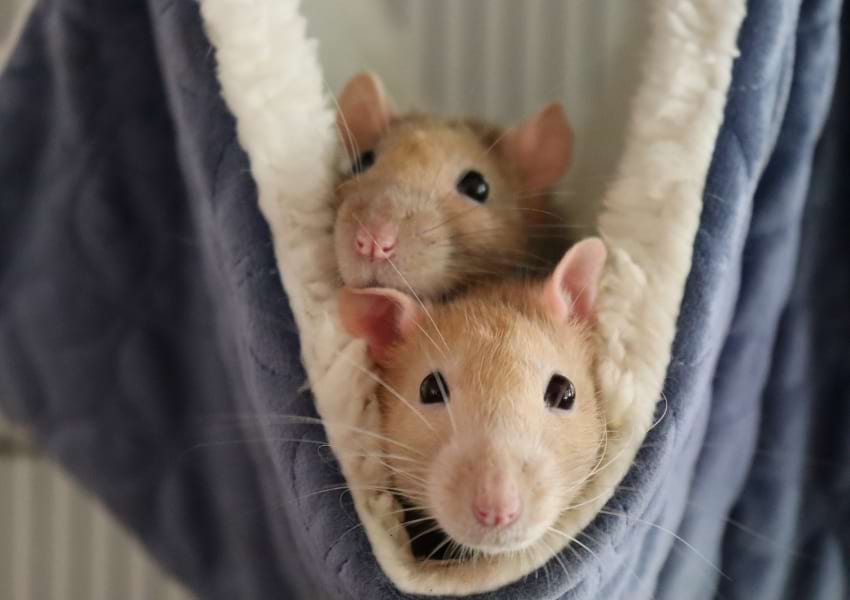
There is no big mystery here – it’s easily explained with a thought experiment. Humans are social creatures too. Think back to when you were a small child. Now imagine that one day, while you are sitting in bed playing with your brothers or sisters, a giant alien comes along, takes you away , and locks you in a small house on their planet. They are nice enough and you quite like them – they give you food and bedding, and even play with you and cuddle you, but you don’t speak their language and they don’t understand yours. None of the things you know instinctively or have learnt so far – about how to interact with others of your kind, or how to tell if things are safe – apply here. And you spend about 22 hours of the day alone in that little, locked house. You sleep alone, you play alone, you eat alone.
It would not be very surprising if you developed some strange behaviors, anything from anxiety to attention-seeking. And you’d very likely be happier if you had friends of your own species , friends who spoke your language, who you could sleep with and play with whenever you wanted.
Most people who keep lone rats love their pets very much and aren’t treating them badly in any way. But just the fact of being alone, however well-loved, shuts out a whole rich part of ratty life.
Will Rats in Groups Bond to Their Owner?
One of the most common reasons I hear for rats being kept alone is the belief that they will bond better to their human that way. It is true that most lone rats, if well handled, will be friendly and love their human. Rats are social and become very attached to their owners.
But this is true even if the rats are living in a group. The Horde currently has 11 members, and they are all bonded to me . Behavior and the closeness of the bond varies between rats because they have different personalities, but they all play with me , have cuddles , come and see me if I open the cage or sit down with them while they are playing.
Every time I walk through their free-range area at least three will appear and sit on my foot to demand to be picked up. If they get spooked, they often treat me as their safe place.
Rats love their humans because if treated well, they make great pets . They want to play and cuddle and be stroked, and play some more, and steal your spectacles… If you keep rats in pairs or groups, you’ll still get all that love, but the rats will have a vital extra dimension to their lives.
Note: I strongly believe rats should be kept in pairs or groups, but these should be either same sex or neutered . I currently have a little rescue girl and 13 babies in my hall because someone didn’t realize that! She and the babies are all healthy now, but the pregnancy almost killed her, and as an owner, you really don’t want to go there .
Alison Blyth has been keeping rats since 2000. After 20 years specializing in rehabilitating animals with medical or behavioral problems, she is now working to breed a line of rats with reduced susceptibility to common health issues.
Similar Posts
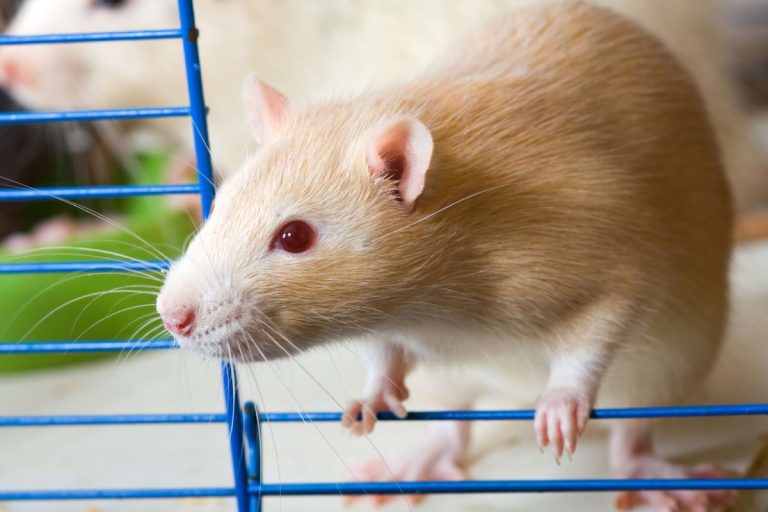
Pet Rat Supplies: Everything You Need to Keep Your Rats Happy & Healthy
Finding somewhere to adopt your new friends is only one part of preparing to own pet rats. You also need to stock up on all the things you need to keep them healthy, happy and comfortable. This post will take you through the key pet rat supplies needed before adopting rats. 1. A Cage Pet…

Our Best Rat Bedding Picks Based on 20 Years of Experience
Choosing what rat bedding to use in a cage is one of the most important decisions a rat owner makes. Rats live in really close contact with their bedding so it is vital that it is safe, comfortable and suited to their needs. Why Do Rats Need Bedding? There are three types of bedding that…

Safe Rat Food List: Veggies, Fruits, Nuts, Seeds, Herbs, Protein & More
Rats can eat a wide variety of animal and plant-based foods. That’s the main reason they’re so successful as a species. They easily adjust to their environment and can survive on all kinds of foods – be it berries and seeds from the woods or trash from the dumpster. But even though they can eat…

Rat Digging Box: How to Set It Up
Rats are intelligent and social animals that need plenty of enrichment to be happy and healthy. Naturally, we want what’s best for our rats, and sometimes small changes can significantly affect their welfare and overall health. Providing a good digging box is one of these changes; digging boxes are easy and cheap to make but…
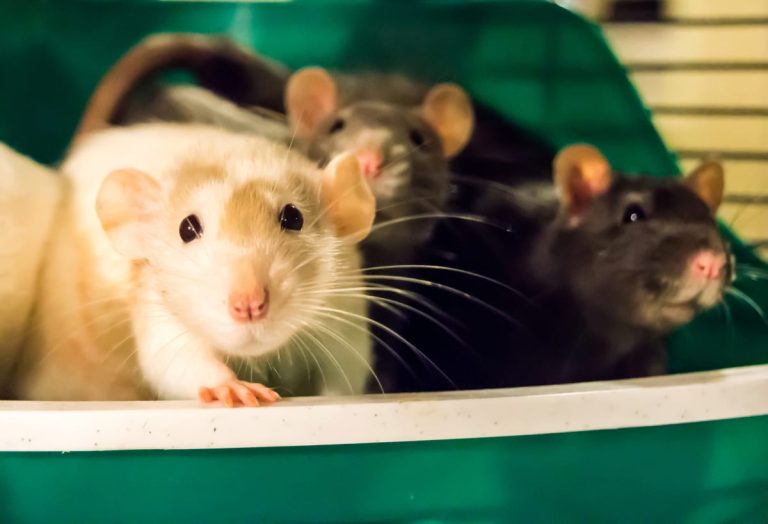
How to Litter Train Your Rats in 3 Easy Steps: A Potty Training Guide
A question I’m often asked by people researching rat ownership is how much do pet rats smell? There is no one answer – it depends partly on the sex (boys have a distinct, although not unpleasant smell), partly on how often the owner cleans them out, and partly on how well they take to litter…

Do Rats Need a Wheel? What Kind of Wheels Are Safe?
While wheels are not an absolute necessity in your rats’ cage, they’re a great addition for exercise and enrichment. Rats in the wild will run significant distances throughout their lives, and when they can, they’ll run to their full length (extending their bodies) and even bunny hop. Allowing your rats the opportunity to run in…
20 Comments
Loved this whole series on pet rats. My grandson found a newborn on his school playground. His eyes weren’t even open. He is now 8 months old and precious. I am Granny Lou and the one that raised him and has bonded with him. I would like to get him a little male friend and looked at this Pinterest site. I feel more comfortable getting him a playmate his own size and gender. He and one of cats play like Tom and Jerry. His name is Like Dude.
Aww that’s so nice of your grandson to save him. We need more people like him on this planet 🙂 Like Dude would definitely benefit from having a ratty friend so I hope you’ll get one!
Good morning. I’ve just been given two 6 month old male rats. Reason for me acquiring them is because, in the previous owners words “I have just lost interest in them” It broke my heart. I’m struggling because they’re living in separate cages, I was told they can live together as the cages do connect with tubes but they kept apart because they didn’t like how big the cage was connected. The previous owners live in a big house. I live in a room … I’m in the military, I literally have a room. So I connected the cages, all seemed fine at first but Dave is clearly the dominant one and had started attacking Grohl, who now hides in the tube. So I separated them but the cages are too small to be like that permanently (in my opinion) I wanted to buy a big tall cage they could share but I’m wondering if I’ll ever get them to re bond? They’re brothers and not neutered. Should I neuter Dave? Would that help? Advice needed! Thank you.
Hello. In my personal experience, I’ve found neutering almost always helps with male rat-to-rat aggression – I’ve never had a neutered male who I couldn’t rebond into a group, and I’ve had some very aggressive rescues in my time (the standout was Mr G who had been used as a stud by some backyard breeder until he hospitalised the girl they were trying to mate him to! But after neutering he settled fine and intro’d to 5 or 6 other unrelated neutered boys). So if you have access to a good vet, that is certainly an option. There are some risks, but with a competent vet they should be pretty low (I’ve lost one rat under anaesthetic since 2000). When bonding / rebonding rats it’s important to do it on neutral territory first (i.e. not either of their cages). I start with the rats in a carrier with food and water under close observation, and when they are snuggled up in there, I move to a small empty clean cage, then a small cage without hidey holes to get territorial over, and only then their main cage. With mine it has taken anything from an hour or so to weeks!
I found my baby rat ouside he was alone, eyes were closed, he was so tiny..his home had been disturbed by people moving my wood..So I thought he was a mouse at first….I put him in my old hamster cage, looked up baby mice and it said they eat goats milk only, so I got some powdered goats milk, added some warm water, and put it in an old syringe I had used for my ole cat of 19 years, who has gone to his reward, and the cute little thing stuck out his pink tongue and lapped it from the syringe for about two weeks, then refused anymore, so got him some food, and also he grew fast, turned out to be a rat…lol lol His name is Lover boy, but he has no companion but me, as I did not know about getting another rat as he was from a wild family, since gone…found one dead on in the back,…so sad..and the rest, have no idea how many were there in the first place… So I am the one who plays with him in the evening….he runs around on the floor and on his special chair, hides from me and peeks out so I can wiggle my fingers etc….. So it is just me, as I had no plans to buy a rat, just rescued him from my three cats, and any other little varmints like like rats to eat.
Your situation is a bit different because you didn’t plan on having a pet rat. But he found you and you were so wonderful to rescue him 🙂 It would be different if you were about to go and buy a pet rat – we always like to suggest people who are planning on getting a pet rat to get at least two because they would be happier in a group.
Hi, I’m so sorry to bother!
I was given two rats for my borthday, and much like this story it was a ‘females’ pair. Imagine my surprise when I saw some very physical evidence that Toast was not a girl! We separated them just at 5 weeks, so I like to assume no pregnancy happened under our nose. It’s only been a week since we got them, and they really don’t seem to be any less skittish.
They came from a home with a very loud, very demanding child that banged on the cage. We did expect quite a bit of timid behaviour based on that, but we also hoped it would be remedied by having them support each other. But now we have to wait a good few months for Toast to get big enough for neutering.
Would you happen to have any advice for calming them until they can be paired again? We’re quite liberal with ‘treats’ (the half their diet that’s supplemented by greens and vegetables) but we still can’t come close to touching them. I’d really like to set them up in a monitored play area but they won’t exit the cage if we’re watching, either.
Sorry for the long rant, and I truly hope you’ll have some advice! Thank you so much!
Hi Katrina, That’s a tricky one. I’d personally get them a little friend each of the right sex, but that does land you with four rats, which may not be your plan! Otherwise, I think you need to work on trust training with each of them – sit and talk to them calmly, offer treats, let them sniff your hand in the cage etc. I often get nervous rats out the cage in a box or tube and put that in my dressing gown or a large sweater that I wear over my clothes, so they can come from a safe space into somewhere warm and enclosed that smells of me – that helps them associated me with safety. An enclosed small play area around their cages may help them feel secure in coming out of their cage in their own time – you could sit in it very still and quiet and see if they’ll come to you. Don’t let them play together (even closely monitored) though, as that is a quick route to babies – rats mate far quicker than a person can move to stop them. In terms of neutering, I’ve done it at 12 weeks several times with no ill effects.
I was planning to buy a companion for my rat since he was the only one left but sadly the poor ratty got an eye injury now I can’t buy any rats because I’m scared while playing one will accidentally pop the eye. It’s buldging and dry (we moisturise it). I don’t wanna risk him he I guess already lost vision though I can’t tell but can still see in his other eye, but he plays with me everyday we let him out of the cage give him treats so he won’t feel lonely. His name is Tip and is a dumbo I really wanted to remove the eye to make his life easier but there is no vets in my area that specialise in rodents
He should be fine as long as you spend enough time with him every day so he doesn’t get lonely 🙂 Thank you for taking such good care of him!
Hi, I currently have an older female, her name is celeste and she is almost 2 yrs. Near the beginning of this year her sister Thea passed away and it was taken hard. Celeste became extremely clingy and wanted nothing to do with other animals or people. Just me and my dad. I give her alot of attention and figured I didnt need to get another rat or two for her yet.
I will be starting a new job in the upcoming weeks that will make it hard to give as much attention to her. And was wondering if I should get two baby rats (off the tit but still young) for her to care for and see if that puts a little perk in her step since she has become a bit lethargic recently.
My only concern is that 1) she has a recurring cyst below her ear, nothing that can be done except its popper and cleaned whenever it shows up, I dont want to put more stress on her unnecessaryaly. And 2) that she wont be interested in them and will become territorial of me. (That’s happened with one of my girls before so I know it’s possible.
That’s a difficult one. It’s likely she would prefer company, but of course we can’t predict how she’ll react in advance. So I can only say what I’d do in the same circumstances – which is get two young rats (around 6-8 weeks) and try careful supervised introductions in a carrier (I use this method http://www.isamurats.co.uk/the-carrier-method.html ). It’s most likely she’ll take to them with no problem, but by doing the intros cautiously you should be able to make sure there are no injuries. For what it’s worth, I’ve only ever had one girl refuse intros, and she’d been alone for her whole life before I took her from rescue. The fact your girl was used to living with her sister makes it much more likely she’ll accept new friends.
My college age daughter recently purchased a male hairless rat. She had gone into the store several times scoping out the pets and noticed each time that this little guys was still there. It made her sad that no one seemed to want him so she brought him home to her apartment. She asked at the store about getting a second rat so he wasn’t alone. They said that they had put another rat in the cage with him and that he was aggressive with it. We are new to rat owning, but have done enough research to know that we do not want him to get any cuts or wounds because he is more apt to get an infection. Do you think that he will be okay being alone? What are your suggestions?
I wouldn’t trust a pet store on this, simply because they won’t have introduced the rats properly. If this little guy was in a cage and they just chucked another male rat in, then of course he would be aggressive – it’s like finding a random stranger sitting in your bed. That’s not to say that he won’t be aggressive to another rat – he might well be – simply that the only info is from a situation where aggression would be expected from all but the most chilled animals. When I’m in this situation (which is frequently, as lone male “aggressive” rescues are my speciality) I intro carefully using the carrier method, making very sure everything is neutral territory and taking the time the rats need, as many lone rats need to relearn how to interact. If there is any amount of aggression then I neuter (I actually neuter almost all my males for health reasons, but some have pushed me into it via behaviour). In twenty years, I have never had a male fancy rat who needed to live alone – but some have taken a couple of weeks to intro, and some have needed to lose the balls. This is the carrier method for intros http://www.isamurats.co.uk/the-carrier-method.html
Hi I have an approximately 6-7 month old rat. He was housed with other rats (I have 7 others that get along fine) but he eventually started relentlessly picking on a certain rat and got to the point where he would brawl with any of them. And not squabbles like full on fighting. So I decided to separate the instigating rat and the other 7 are fine. I have tried reintroductions several times but all end in fights. He is fine with humans never bites (is not especially cuddly but will shoulder sit and take food). He has a large cage and gets a lot of human interaction but I would love to have him with his colony if possible. I am hesitant to neuter (just worried about complications, aftercare stitches being pulled—we live in remote area so would be a long trip to an emergency vet, and ultimately that it may not help with the issue.) my question is how confident would you be that this would really correct this issue? Any suggestions appreciated.
Hi Erin, I can’t make a direct judgement on your rat as I’ve never met him, but I can tell you my own stats! In 20 years I’ve had one boy whose aggression towards other rats wasn’t fixed by neutering. That’s against mid-double figures who were. I’ve also lost one rat in 20 years to surgical complications from neutering (heart attack coming round from the anaesthetic). I’ve had a few stitch chewers along the way, but none in 8 years with my current vet, so I think those sort of wound issues are more about how the wound is sealed and the post-op pain management (my current vet uses opiates and metacam in tandem). I personally choose to neuter any aggressive male rat as I think it is a better option than keeping them alone, but all owners have to make the choice that works for them. A good place to start is talking to your vet about their experience and confidence with the procedure. I should add that if you have him neutered, it takes a few weeks for hormones to settle so I wouldn’t try new intros until at least 3 weeks after the procedure. If you try and he is still floofy, give it another couple of weeks before trying again as there is a lot of variation in how quickly they settle.
Hi! I found a rat at my local pet shelter and fell in love with her. She was a rescue, though, and doesn’t have a friend. There are no other rescue rats within 100 miles (as far as I know), and she’s going to be euthanized soon. Should I take her? Should I leave her? If I take her, should it be solitary, or should I try and find a rat from a pet store (ugh, I hate supporting their business) to be her friend? Thanks!
Hi River, If you are in a position to look after her, I would take her and get her a friend or two. Although I don’t advocate buying from pet stores, I think it’s ok to do when it is to ensure the welfare of another rat by providing them with company that can’t be found from better sources. I hope I replied in time!
Hi! Unsure if you’ll reply to this because it’s been quite some time, but I would like some help!
I had three rats– Remy, Linguini, and Buttercup. Remy was the youngest, but died to an unknown cause on the last day of November. Linguini passed away yesterday to a respiratory illness. Just Buttercup and I again (she was my first rat and has had many companions die over the two years I’ve had her…), and I was wondering if I need to get more rats again. Of course I will not be sad if I do, I love rats so much and want to give Buttercup the best life possible, but she’s been through so much lately and I want to know when’s the best time to get her new ones.
Hi G, This is my personal approach, rather than gospel (because all rats and owners and situations are unique), but where I am comfortable getting new rats, I always do that rather than have a lone rat. From a rat point of view, I find sooner is better as it gives them a social interest and can often help them get over the loss of previous cage mates. Hope that is helpful,
Leave a Reply Cancel reply
Your email address will not be published. Required fields are marked *

Do Rats Travel Alone? (The Answer May Surprise You!)
Do Rats Travel Alone?
Rats are social creatures that live in colonies. They typically travel in groups for protection and to find food. However, there are some cases where rats may be seen traveling alone. This can be due to a number of factors, such as being kicked out of their colony, being lost, or being on a mission to find food.
In this article, we will explore the reasons why rats travel alone, the dangers they face when they are on their own, and how they communicate with each other. We will also discuss the role that rats play in the ecosystem and how they can be beneficial to humans.
Rat Behavior
Rats are social animals that live in colonies. They communicate with each other using a variety of vocalizations, including squeaks, whistles, and trills. Rats also use their tails and whiskers to communicate.
How do rats communicate?
Rats communicate with each other using a variety of vocalizations, including squeaks, whistles, and trills. These vocalizations are used to convey a variety of messages, such as alarm, danger, food, and mating. Rats also use their tails and whiskers to communicate. Their tails are very sensitive and they can use them to touch each other and to sense danger. Rats also use their whiskers to feel their way around in the dark.
What are the different types of rat social structures?
Rats live in colonies of varying sizes. These colonies can be as small as a few rats or as large as hundreds of rats. The social structure of a rat colony is based on dominance. The dominant rats are the ones that have the most access to food and resources. They also have the most control over the other rats in the colony.
How do rats interact with other animals?
Rats are opportunistic feeders and will eat anything they can find. They are not picky eaters and will eat both plants and animals. Rats will also eat other rodents, birds, and even snakes. Rats are also known to carry diseases, such as rat-bite fever and leptospirosis.
Rat Migration
Rats are known to migrate long distances in search of food and shelter. They can travel great distances by land, sea, and air. Rats are also very good swimmers and can swim for long distances.
Why do rats migrate?
Rats migrate for a variety of reasons, including:
- Food: Rats are opportunistic feeders and will migrate in search of food. They are especially likely to migrate during times of drought or famine.
- Shelter: Rats also migrate in search of shelter. They are attracted to warm, dark places, such as buildings, sewers, and attics.
- Climate: Rats are also known to migrate in response to changes in climate. They are more likely to migrate to warmer climates during the winter months.
How do rats travel?
Rats can travel long distances by land, sea, and air. They are very good swimmers and can swim for long distances. Rats can also climb trees and use their tails to help them balance.
The challenges of rat migration
Rat migration can pose a number of challenges, including:
- Disease transmission: Rats are known to carry a variety of diseases, such as rat-bite fever and leptospirosis. When rats migrate, they can spread these diseases to new areas.
- Property damage: Rats can cause a lot of damage to property. They can chew through wires, damage furniture, and contaminate food.
- Health hazards: Rats can also be a health hazard. They can carry fleas and ticks, which can transmit diseases to humans. Rats can also contaminate food and water supplies.
Rats are fascinating creatures that are capable of amazing feats. They are highly adaptable and can survive in a variety of environments. Rats are also social animals that live in colonies. They communicate with each other using a variety of vocalizations and body language. Rats are also known to migrate long distances in search of food and shelter. When rats migrate, they can pose a number of challenges, including disease transmission, property damage, and health hazards.
Rats are social animals that live in colonies. They typically travel in groups of 10-20 individuals, but they can sometimes form colonies of up to 100 rats. Rats are very territorial and will defend their territory from other rats. They will also travel long distances to find food and shelter.
Rats are nocturnal animals, so they are most active at night. They will typically travel during the night to avoid predators. Rats are very good climbers and can climb up walls and trees. They can also swim and will often travel across bodies of water.
Rats are very adaptable animals and can live in a variety of habitats. They can be found in homes, businesses, farms, and even in the wild. Rats are attracted to food and shelter, so they will often travel to areas where they can find these things.
Rats can be a nuisance and can also carry diseases. If you have a rat problem, it is important to take steps to get rid of them. There are a number of different methods of rat control available, so you can choose the one that is right for you.
Rat Control
There are a number of different methods of rat control available. Some of the most common methods include:
Trapping is one of the most effective methods of rat control. There are a variety of different traps available, so you can choose the one that is right for you. Baiting is another effective method of rat control. Baits can be used to attract rats to traps or to kill them. Poisoning is a third method of rat control. Poisons can be used to kill rats, but they can also be dangerous to other animals and children. Exclusion is a fourth method of rat control. Exclusion involves sealing up any holes or cracks in your home or business that rats could use to enter.
The best way to control rats is to use a combination of methods. This will help to ensure that you are successful in getting rid of the rats.
Rats and Human Health
Rats can carry a number of diseases, including:
- Leptospirosis
- Rat-bite fever
- Salmonellosis
These diseases can be spread to humans through contact with rat urine, feces, or saliva. They can also be spread through the bites of rats. If you think you have been exposed to a rat-borne disease, it is important to see a doctor immediately.
There are a number of things you can do to protect yourself from rat-borne diseases, including:
- Keep your home and property clean and free of food and water sources.
- Seal up any holes or cracks in your home or business that rats could use to enter.
- Keep your garbage in covered containers.
- Do not leave pet food out overnight.
- If you see a rat, do not try to catch it yourself. Call a pest control professional.
Rats are a nuisance and can also carry diseases. If you have a rat problem, it is important to take steps to get rid of them. There are a number of different methods of rat control available, so you can choose the one that is right for you. By taking steps to control rats, you can protect yourself and your family from the health risks associated with these pests.
Do rats travel alone?
No, rats are social animals and typically live in colonies. They are very good at communicating with each other, and they use a variety of sounds, smells, and body language to interact. Rats are also very territorial, and they will defend their territory from other rats.
Why do rats travel in groups?
There are a few reasons why rats travel in groups. First, rats are social animals and they enjoy the company of other rats. Second, rats are more likely to survive if they are in a group. Rats can help each other find food, find shelter, and defend themselves from predators. Third, rats are territorial animals and they will defend their territory from other rats. By traveling in groups, rats can more effectively defend their territory from other rats.
How far can rats travel?
Rats can travel long distances, especially if they are looking for food or shelter. Rats have been known to travel up to 20 miles in a single night.
What are the dangers of rats traveling?
Rats can carry a variety of diseases, including rabies, leptospirosis, and plague. They can also contaminate food and spread other pests, such as fleas and ticks. Rats can also be a nuisance, as they can chew through wires, damage property, and make noise.
How can I prevent rats from traveling into my home?
There are a number of things you can do to prevent rats from traveling into your home. First, keep your home clean and free of food scraps. Rats are attracted to food, so if you don’t have any food for them, they won’t be interested in coming into your home. Second, seal up any holes or cracks around your home that rats could use to enter. Rats are very good at squeezing through small spaces, so it’s important to make sure that your home is completely sealed. Third, install a rodent-proof door sweep on your front door. This will help to keep rats from entering your home through the bottom of your door.
What should I do if I see a rat in my home?
If you see a rat in your home, it’s important to take action to remove it. Rats can be dangerous, so it’s important to get rid of them as quickly as possible. There are a number of different ways to remove rats from your home, including trapping them, using repellents, and hiring a pest control company.
rats are social animals that typically travel in groups. They use a variety of cues to navigate and communicate with each other, and they rely on each other for protection and support. While rats can survive on their own, they are more likely to thrive when they are part of a community.
Here are some key takeaways from this discussion:
- Rats are highly social animals that live in complex social hierarchies.
- Rats use a variety of cues to navigate and communicate with each other, including vocalizations, pheromones, and tactile cues.
- Rats rely on each other for protection and support.
- Rats are more likely to thrive when they are part of a community.
Author Profile

Latest entries
- January 19, 2024 Hiking How to Lace Hiking Boots for a Perfect Fit
- January 19, 2024 Camping How to Dispose of Camping Propane Tanks the Right Way
- January 19, 2024 Traveling Information Is Buffalo Still Under Travel Ban? (Updated for 2023)
- January 19, 2024 Cruise/Cruising Which Carnival Cruise Is Best for Families?
Editorial: California’s rat poison bans aren’t working. Wild animals and pets are still dying

- Show more sharing options
- Copy Link URL Copied!
For at least a decade, California has tried to restrict the use of rat poison so it stops killing all manner of creatures besides rats. So far, it hasn’t worked.
When a wild animal preys upon a rat that has ingested anticoagulant rodenticide, it can end up dead or sickened by the toxin as well. The poisoning continues up the food chain from predator to predator. Mountain lions, bobcats, foxes, coyotes, hawks as well as endangered species including the northern spotted owl and San Joaquin kit fox are among the wildlife that have been either killed by these rodenticides or made so ill that they can’t navigate their environment, hunt for food or dart across a road efficiently.

Editorial: California’s pumas are worse off than we thought. They need immediate help or could die off
If mountain lions can’t cross a road to find mates and territory without risking their lives, that’s an eventual death sentence for the local population.
Jan. 26, 2024
Anticoagulant rodenticides didn’t kill P-22, the beloved Griffith Park mountain lion, but they turned up in his system a couple of times — once causing a bout of mange for which he was lucky enough to receive treatment. Several different rat poisons were found in his system after he was euthanized in 2022, including diphacinone, a first-generation anticoagulant. Both of these rat poisons kill by causing internal bleeding. The older first-generation version is slower-acting, requiring the rat to feed on the poison several times before it is killed by it. The second-generation version kill rats more quickly.
Ten years ago the state prohibited the commercial sale of the more potent and fast-acting second-generation anticoagulant rodenticides, allowing them only to be used by professional exterminators. In 2020, the state Legislature decided to extend the ban to professional uses as well, except in some agricultural settings and in public health emergencies.

Opinion: When a dog bites, it’s probably because you weren’t paying attention
Bites are sending record numbers of Californians to the ER. Here’s how to prevent that from happening to you.
March 12, 2024
But the law still allowed consumers and professional exterminators to use first-generation rodenticides, which don’t act as quickly but still carry a powerful toxicity capable of sickening and sometimes killing the birds , mountain lions and other creatures that prey upon rats. A recent study of red-tailed hawks that ate prairie dogs poisoned with diphacinone showed signs of blood-clotting and trouble regulating their body temperatures.
Despite these efforts, non-target animals are still being poisoned by rodenticides, whether by accident or improper use. Necropsies of wild animals over the years have shown that wild animals and pets continue to end up as collateral damage of these toxins. Last year, state lawmakers adopted a moratorium on the use of diphacinone , the first-generation rodenticide most commonly found in the systems of poisoned wildlife, except in agricultural settings and public health emergencies. That ban took effect in January, so it has yet to have an impact, but there’s more that needs to be done to stop these terrible toxins.

Opinion: Is the restoration of California’s cutest keystone species worth it?
Since the 1960s, a remnant population of sea otters has revived Monterey Bay. But they can’t migrate north throughout their historic range without human help.
Feb. 17, 2024
Assembly Bill 2552, introduced this year by Laura Friedman (D-Glendale), could help curb the use of banned rodenticides by empowering all Californians to become enforcers. The bill, which is sponsored by wildlife advocacy groups, would allow members of the public to sue a person or company illegally using banned rodenticides. State and county agencies are tasked with enforcing the rodenticide laws but can’t begin to stop all the violations of the laws.
The bill also expands the ban to the remaining first-generation rodenticides, warfarin and chlorophacinone. And it forbids the use of all restricted rodenticides in parks and wildlife refuges, or within 5,000 feet of one.
This bill is crucial to ridding the environment of these toxins that kill wildlife and pets and have been known to poison people — usually children — as well.
And there’s no need for them. Covering trash receptacles, sealing up entry points to a house or building, and using nontoxic rodenticides and traps that don’t cause pain are all safer options to control rat populations. Fertility control products are also being used. One type is a plant-based liquid in bait stations that lowers fertility in rats (which breed prolifically). The liquid, which rats find delicious, has no hormones or chemicals to harm animals that prey upon rats. Various trials in city neighborhoods across the country have shown results as dramatic as a 90% reduction in rats after several months.
The text of the bill makes a point of stating that animals are capable of experiencing pain, stress and fear, and that they have “a right to a life free of poison.”
That language doesn’t imbue animals with rights that override human rights. If that were the case these rodenticides would be banned with no exceptions. But it does underscore something important — that humans should strive to minimize animals’ suffering especially when it is unnecessary. That is the case here.
More to Read

Letters to the Editor: It’s 2024, and humans are still using rat poison to kill animals?
March 20, 2024

Burrowing owl faces ‘death by a thousand cuts,’ advocates say
March 11, 2024

Ojai becomes 2nd U.S. city to ban ‘horrible, indiscriminate killing devices’: glue traps
March 4, 2024
A cure for the common opinion
Get thought-provoking perspectives with our weekly newsletter.
You may occasionally receive promotional content from the Los Angeles Times.
The Los Angeles Times’ editorial board determines the positions of The Times as an institution. It operates separately from the newsroom. You can read more about the board’s mission and its members at About The Times Editorial Board .
More From the Los Angeles Times

Commentary: Kate Middleton, the Princess of Wales, has cancer. How awful was all our speculating?
March 22, 2024

Editorial: L.A.’s golf reservation system allows people to hog tee times. That’s wrong

Editorial: Hold the applause. Biden’s new EV rules don’t go fast enough for the climate crisis

Editorial: The LAPD needs a better way to fire cops. So why are city leaders slow-walking reform?
March 21, 2024
pestwhisperer.com
We'll help you get rid of those pesky pests!
Can Rats Be Alone?

Single rats often develop behavior problems and neurotic tendencies. One owner reported that her single female became possessive and clingy when she was taken out of her cage. She also threatened anyone who came near “her” human. After she had a cagemate introduced to her at six months old, her behavioural problems disappeared and she is now a happy, healthy companion.
It’s important to remember that rats are social animals and can get lonely if they aren’t surrounded by other animals. Keeping your rat companions together is the best way to reduce their loneliness. However, if you decide to add a new rat, you’ll need to introduce it slowly and separate the older rat from the new one.
Rats that live in groups often live longer, more active lives. When they live in groups, they get to participate in more activities and are less likely to experience loneliness. In addition, isolated rats often become chewy and neurotic. You’ll need to provide companionship for your rat to keep him happy and healthy.
Although rats can live alone, they prefer to be in groups and pairs. In the wild, rats live in large family groups. Compared to hamsters, rats enjoy the company of other rats. In addition to playing with each other, rats bond with each other through touch, smell, and sound at frequencies humans can’t hear. Since rats need each other to be happy and healthy, they do best with other rats.
Continue reading:

- Cockroaches
Recent Posts
- Can Roaches Take Flight? Debunking Myths & Facts about Roaches
- How to Eliminate Pesky Flies: Effective Tactics & Tips
- Dobsonfly Mysteries Unveiled: Habitat, Lifecycle, and Lore
- Bot Fly Intrigue: Lifecycle to Removal Insights
- Crane Fly Mysteries Unveiled: Lifecycle, Habitat, and Myths
Alabama , Alaska , American Samoa , Arizona , Arkansas , California , Colorado , Connecticut , Delaware , District of Columbia , Florida , Georgia , Guam , Hawaii , Idaho , Illinois , Indiana , Iowa , Kansas , Kentucky , Louisiana , Maine , Maryland , Massachusetts , Michigan , Minnesota , Minor Outlying Islands , Mississippi , Missouri , Montana , Nebraska , Nevada , New Hampshire , New Jersey , New Mexico , New York , North Carolina , North Dakota , Northern Mariana Islands , Ohio , Oklahoma , Oregon , Pennsylvania , Puerto Rico , Rhode Island , South Carolina , South Dakota , Tennessee , Texas , U.S. Virgin Islands , Utah , Vermont , Virginia , Washington , West Virginia , Wisconsin , Wyoming
Our top picks for getting rid of rodents
These are our 6 TOP picks for getting rid of your rodent infestation. These products are carefully selected by our team to give you the most value for your money!


COMMENTS
While brown rats typically hunt alone, black rats work together to ensure that all members of a nest or group have ample food supplies. ... slightly flattened strips of grass indicating "runways" or common routes of nighttime travel, and the presence of droppings which are brown, cylindrical pellets that are usually about 1/2 -1 inch long ...
There are nearly 60 known rat species around the world.(Image credit: Getty) Rats are thin-tailed, medium-size rodents that originated in Asia and Australia but are now found all over the world ...
Travel in Packs. Rats are social creatures and may travel in groups, especially when young rats follow their mother to learn foraging paths. However, older rats are more likely to forage alone. Ability to Return to the Same Nest. Rats have a strong homing instinct and can return to their nest even after traveling considerable distances.
Packing it in Now that you know where rats live, it's logical to wonder, "Do rats live alone?" Or do rats live in packs? The answer is in packs. ... A Washington Department of Fish and Wildlife factsheet explains the social and family structure of these rats: Old World rats travel 50 to 300 feet from their nests to look for food and water and ...
But the answer is not a simple one. If you see 1 mouse, there might be more. But then again, there might not be. Mice are very social animals, so they are more likely to travel in packs. Let's not forget that mice are wicked-fast breeders, so they will also live and travel with their families. If you notice a mouse problem in your home, you ...
No. Rats do not live alone. Rats are always known to be social creatures, and they always like it when they are with others of their kind. In the rat population, they tend to form very tight family bonds. ... In most cases, they travel in search of food and nesting materials to keep them warm. Where rats live during the day may be your concern ...
This article explores the social habits of rats and their behavior when traveling in packs. It looks at the science behind rat pack formation and communication, as well as the advantages and disadvantages of group living. It also examines how rats survive while traveling in groups, including foraging for food, avoiding predators, and building nests.
They have great memories, so once they map out a room they will remember all of the routes for a long time. However, rats do have poor eyesight, so they have to use their whiskers to get around. They use their tails for balancing purposes and to regulate their body temperatures. They can also communicate with other rats via their tails.
In New York alone, up to six million people use the subway system every day, coming into close proximity with rats, and nearly one-fourth of more than 7,000 restaurants inspected so far this year ...
These creatures prefer to travel in pairs or groups. There's strength in numbers, and traveling as a pack offers more protection. Mice also move as a unit to migrate the colony. It's rare to find a mouse nest with only a single rodent. They create a large nest, and every mouse works to support it (more on that in a bit).
When Do Rats Leave The Nest? Young rats will leave the nest at the age of about 3 months. This is shortly after they have learned, through imitation from their mother, what foods are good to eat. At 3 months, rats are mature enough to reproduce and travel alone. All rats are nocturnal and will leave their nest from the start of dusk until dawn ...
Rats do best in pairs or even better, in groups. Rats are naturally sociable animals and instinctively stay together (in what is called a mischief). You can observe this in wild rats. Solitude is known to negatively impact a rats well-being and quality of life. A pet rat that lives alone may not necessarily have a shorter lifespan than rats ...
Rats tend to build a nest close to a reliable food source, so they don't have to travel too far. However, when food is in short supply, they've been known to travel more than their average range of 50 to 200 feet from the nest. A rat needs to consume up to 10% of its body weight in food every day.
The Importance of Company for Rats. Rats are intelligent creatures that require mental stimulation and companionship to lead fulfilling lives. Without social interaction, they can become bored, lonely, and may experience decreased overall well-being. When rats are kept alone, they can exhibit signs of stress, depression, and behavioral issues.
Rats can travel up to 90 meters from their nest. Normally however, they will only travel as far as in necessary to find food, water, shelter, or nest building materials. As nocturnal creatures, rats do most of their exploring at night. How do rats navigate? Rats follow their noses. A rat's sense of smell is significantly more powerful than ...
Rats are excellent climbers, and they can scale walls and trees. They also have good memories and can remember a route for a long time. They can also move under things to hide their movement. When they're active, rats can travel up to 150 feet from their nest, but they can travel much farther in search of food.
Rats Are Social Creatures As a general rule, rats will live in groups that are known as packs. The pack is started by a male and female rat and then will grow over time. Some packs may just have a single male with multiple females while others may have multiple dominant males in a single group. It is possible that you have a single rat or just ...
Rats can travel about three hundred to five hundred feet to find food. They may also travel further if their food supply is scarce. If you want to get rid of rats fast, you should consider getting rid of them through rodent control. These pests can cause damage to your home so it is important to get rid of them as soon as you can.
Wouter September 26, 2022September 26, 2022. Rats are nocturnal creatures and can travel quite a distance. The typical range of a rat is between 100 and 300 feet, but some rats can travel over two miles. In most cases, rats travel a short distance, such as from their nest to a nearby area that contains food. When food becomes scarce, rats pack ...
It is true that most lone rats, if well handled, will be friendly and love their human. Rats are social and become very attached to their owners. But this is true even if the rats are living in a group. The Horde currently has 11 members, and they are all bonded to me.
Do Rats Travel Alone? Rats are social creatures that live in colonies. They typically travel in groups for protection and to find food. However, there are some cases where rats may be seen traveling alone. This can be due to a number of factors, such as being kicked out of their colony, being lost, or being on a mission to find food. ...
The distance depends on several factors including the species of rat, the weather, and the ability of the rat to find a new home. Some rats will travel as far as 2 miles away from their nests. However, they can also travel much shorter distances to reach water or food sources. When a rat is far from its nest, it is very anxious and will go in ...
The liquid, which rats find delicious, has no hormones or chemicals to harm animals that prey upon rats. Various trials in city neighborhoods across the country have shown results as dramatic as a ...
You'll need to provide companionship for your rat to keep him happy and healthy. Although rats can live alone, they prefer to be in groups and pairs. In the wild, rats live in large family groups. Compared to hamsters, rats enjoy the company of other rats. In addition to playing with each other, rats bond with each other through touch, smell ...